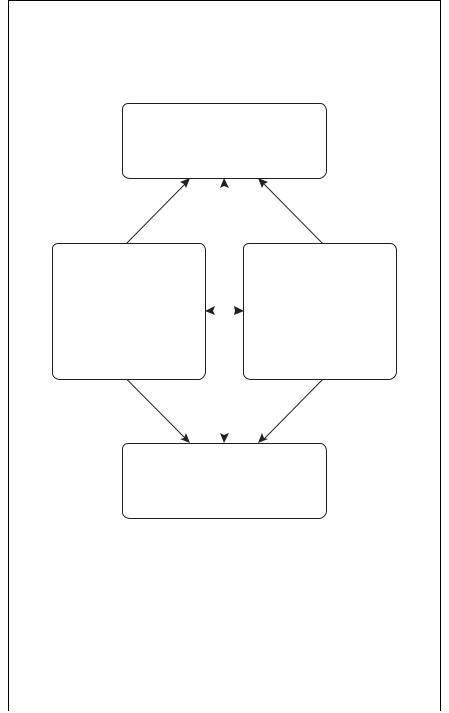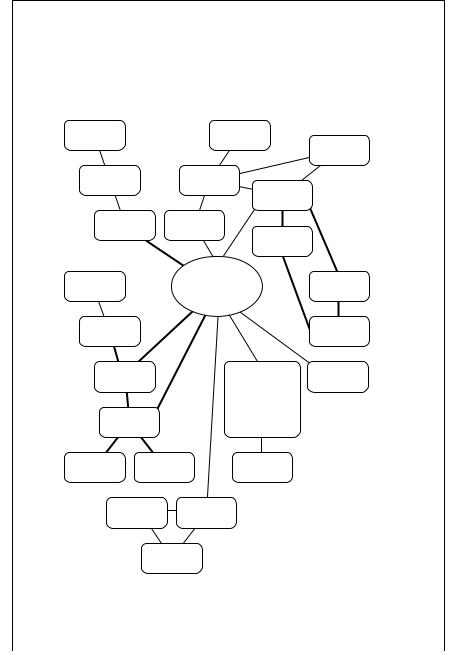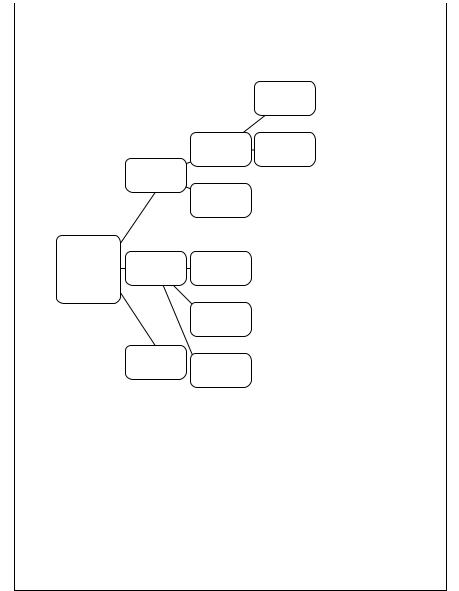
- •Contents
- •List of illustrations
- •List of tables
- •List of boxes
- •Foreword
- •Preface
- •Acknowledgements
- •1 Introduction
- •2 Key words in brand management
- •4 The economic approach
- •5 The identity approach
- •7 The personality approach
- •8 The relational approach
- •9 The community approach
- •10 The cultural approach
- •11 Taxonomy of brand management 1985–2006
- •Notes
- •Name Index
- •Subject Index

5The identity approach
with a commentary by Professor Majken Schultz, Copenhagen Business School, and Professor Emerita Mary Jo Hatch, University of Virginia
Learning objectives
The purpose of this chapter is to:
Understand the assumptions of the identity approach
•The brand should express one unified and coherent identity, internally as well as externally, by using the visual and behavioural identity of the corporation to build the brand
Understand the theoretical building blocks of the identity approach
•The four supporting themes of brand identity: corporate identity, organizational identity, image and reputation
•The two frameworks: the corporate brand tool kit and theAC2ID model are useful for the alignment of corporate identity, organizational identity, image and reputation to create a coherent brand identity
Provide insights into the methods of the identity approach
•In the identity approach a mix of methods is used. Internally, focus is on corporate identity (visual and strategic) and organizational identity (behaviour and culture) rooted in ethnographic and anthropological methods. Externally, the element’s image and reputation combine methods stemming from cognitive and social psychology
Understand the managerial implications
•Understand the complexity of managing brand identity by ensuring alignment of corporate identity, organizational identity, image and reputation
48 Seven brand approaches
In 1907, AEG appointed Peter Behrens to be what at the time was called ‘Artistic Consultant’. His job turned out to be the first corporate engagement in the conscious management of identity. Peter Behrens’s philosophy was simple – the products, design and communication should express one unified identity. To accomplish this, he created products, logos, advertising material and company publications with a consistent, unified design. This unified design and visual expression of identity make Peter Behrens and AEG the founders of the rationale behind the identity concept and corporate identity management programmes in practice. Identity programmes have since been an integral part of marketing.
In the late 1980s and early 1990s, this line of thought began to take shape in the context of brand management, laying the ground for the identity approach. Abratt (1989) elaborated on the conceptual development of the approach by adding an indepth study of the dimensions that link the interior processes (corporate identity) with the exterior-focused activities (corporate image). A new stream of research has, especially in a European context, during the 1990s led to a conceptualization of brand identity, where the interplay between corporate identity, organizational identity, image and reputation provides the elements for brand identity.
In brand management, the identity construct has grown increasingly popular, because it is a powerful and complex concept with the potential of strengthening competitive power significantly. Most companies today build and manage identity to ensure that the brand identity expresses an exact set of values, capabilities and unique sales propositions.
Unlike several of the other brand management approaches described in this book, the conceptualization and evolution of the identity approach in brand management is primarily practitioner-led. This means that the core definitions and conceptualization of the identity approach are not the result of a single comprehensive breakthrough study (as is the case in the consumer-based, the personality, the relational and the community approaches), but rather based on practical experience from the use of the identity concept as a management tool. There are, however, many influential articles and books worth mentioning in relation to the identity approach. We will refrain from listing the complete selection but mention two collections that in particular have set the scene in the recent perspectives on brand identity. The Expressive Organization by Schultz et al. (2000) is a selection of articles exploring the identity domain from multiple academic fields, with the aim of discussing the relational differences between identity, image and culture in organizations with the aim of clarifying and articulating the theoretical domain of identity (Schultz et al. 2000). Revealing the Corporation: Perspectives on Identity, Image, Reputation, Corporate Branding, and Corporate-level Marketing (Balmer and Greyser 2003) is another important collection guiding the reader through influential classics and contemporary academic articles shedding light on different perspectives on identity, image, reputation and corporate branding.
This chapter offers an overview of the essence of the identity approach, by providing insights into the assumptions, theoretical elements and methodologies underlying the identity approach. Finally, the chapter describes and discusses the

Corporation |
Brand identity |
Consumer |
Figure 5.1 Sources of brand identity. The corporation is pivotal for the creation of brand equity in the identity approach
managerial guidelines that can be accumulated from the most prominent research publications and key non-research literature, supplemented with illustrative cases of how companies have dealt with the management of brand identity in practice.
Assumptions of the identity approach
The economic approach assumes that attributes related to the Four Ps of marketing (product, price, placement and promotion) are the main mechanisms behind the creation and management of brand equity.
The identity approach brings into focus the creation of a unified, visual and behavioural identity. It is assumed that consumers attribute identity characteristics to companies and that people form images of companies based on the total experience of the company. This places the corporation and its employees at the centre of brand equity creation. The identity approach hence adds the importance of the identity of the corporate branding to the theoretical domain of brand management.
The corporate identity perspective
As mentioned in the introduction, the identity concept has a long history from the field of marketing (both in research and in practice) and many of the concepts used and studied in marketing have been applied to the use of the identity concept in brand management. The identity approach is hence multidimensional and draws on a selection of very diverse academic fields such as graphic design and strategic management, organizational culture studies and organizational behaviour. Before seeking a proper understanding of the assumptions underlying the identity approach it is therefore necessary to know how the identity concept has been played out in the field of marketing prior to its adaptation to a brand management context.
Box 5.1 The identity concept adopted from marketing
There were two main streams of practical use of and research in the identity concept in marketing before it became important in a brand management context. One focused on visual identity while the other focused on behavioural identity. These two concepts and their conceptualization in marketing will be explained here:

50 Seven brand approaches
Visual identity
Wally Olins is a brand identity pioneer. In his first big publication about corporate brand identity, The Corporate Personality: An Inquiry into the Nature of Corporate Identity (1978), he described the rationale of the identity concept. Olins advocates the importance of identity for corporate entities and poses two questions that are still considered pivotal in the identity approach today: What are we? and Who are we? Olins focuses on answering these questions primarily through a visual expression of the essence of the identity. Still, he acknowledges that identity is not only about appearance but also about behaviour. Olins advocates that corporations use systems of visual identification to build identity as a communication vehicle. The communication should uphold a consistent visual expression while still ensuring that the brand remains fashionable by undergoing continual adaptation to emergent changes.
Behavioural identity
Kennedy laid the ground for the conceptualization of behavioural identity in 1977. She hypothesized that consumers base consumption decisions on their perceptions of company personality to a much greater extent than on rational evaluation of attribute functionality. Consumer perception of identity is, according to Kennedy, based on the total experience of the company the consumer gets through all the contacts consumers have over time with the brand/company. This line of thought adds the employees and their behaviour as a key factor when building identity.
In a brand management context, the key assumption of the identity approach is that all marketing and communication activities should be integrated, aligned and elevated from a product-focused and tactical level to a strategic, corporate level. Only in that way will it be possible to create a coherent company experience for the consumer. It is from that assumption that the idea of corporate branding and integrated market communication stems. The notion of identity is applicable to the individual brand level, but corporate branding plays a vital role in the identity approach because alignment of all communication in one unified identity requires strategic-level brand management. Identity is something that is initiated from inside the company. Some of the questions corporations need to ask themselves are in the identity approach. Who are we? What do we stand for? What do we want to become? Brand value creation is hence dependent on finding the right answers to these questions and implementing them in every aspect of the business.
From product to corporate branding
Traditionally, the general notion of the classic brand management system has been that each individual product must have an individual and distinct product brand

The identity approach 51
identity. However in the identity approach focus is often on a corporate as opposed to product level branding. The idea of corporate branding is the assumption that creating one unified (at corporate level) message across all functions will elevate brand management from a tactical operational discipline involving only the marketing and sales department to a strategic, corporate level involving the whole organization. Creating one unified message across functions hence requires one unified corporate identity.
Corporate branding implies deserting product branding with its narrow marketing-driven focus on tactical, functional processes. Product branding has been criticized for having a too narrow, external perspective, detached from the organization behind the products. Corporate branding is an attempt to accommodate these weaknesses. Product branding is based on short-term advertising ideas, while corporate branding is based on a long-term brand idea. Corporate branding also expands the parameters of differentiation by enabling companies to use their rich heritage actively to create strong brands. Corporate branding involves the whole organization and emphasises the pivotal role employees play if they are to succeed in the creation of a strong corporate brand. Values and beliefs held by employees are key elements in the differentiation strategy. Corporate branding is a ‘move towards conceiving more integrated relationships between internal and external stakeholders linking top management, employees, customers and other stakeholders’ (Schultz et al. 2005, p. 24).
Table 5.1 Product and corporate branding
|
Product branding |
Corporate branding |
Foundation |
Individual products |
The company/organization |
Conceptualization |
Marketing, outside–in |
Cross-disciplinary, combines |
|
thinking |
inside–out and outside–in |
|
|
thinking |
Brand receivers |
Consumers |
All stakeholders |
Core processes |
Marketing and |
Managerial and |
|
communication |
organizational processes |
Difficulties |
• Create and sustain |
• Alignment of internal and |
|
differentiation |
external stakeholders |
|
• Involvement of |
• Create and communicate |
|
employees and use of |
credible and authentic |
|
organizational cultural |
identity |
|
heritage |
• Involvement of multiple |
|
• Limited involvement |
subcultures internally, and |
|
of stakeholders other |
multiple stakeholders |
|
than consumers |
externally |
Brand equity comes from |
Superior product attributes, |
The visual and behavioural |
|
good advertising |
identity of the corporation |
|
and communication |
|
|
|
|
Source Schultz et al. (2005), by courtesy of Copenhagen Business School Press.

52 Seven brand approaches
This is why organizational and managerial processes are in focus in corporate branding: only in that way can the distinctive identity of the corporate brand be reflected in and nurtured by the way the organization works. Strategy making in corporate branding should take a multidisciplinary approach because it involves not only marketing, but multiple functions and departments.
Alignments between the origin and everyday practices of the organization [organizational culture]; where the organization aspires to go [strategic vision]; how the organization is perceived by external stakeholders [images]; all nested in perceptions of who the organization is [identity].
(Schultz et al. 2005, p. 24)
Corporate branding focuses on developing distinctive features of the organization through organizational and managerial processes. Breaking down the silos between marketing (externally focused) and organizational development (internally focused) and using internal organizational resources to build brand identity, image, reputation and corporate branding have increasingly become an integral part of brand management, and practitioners ascribe corporate culture as one of the most important aspects when conceptualizing the domain of identity. The case of how Lego has shifted from a focus on product branding to corporate branding is a good example of how this shift can be done in practice.
Box 5.2 From product to corporate branding at Lego
In the mid-1990s Lego – the fourth biggest producer of toys in the world – was caught in a general decline in the toy market. For most people Lego is synonymous with the Lego brick, which was also the focus internally. The product focus was perceived as an impediment to growth. Lego had to reinvent the company by implementing a shift from product branding to corporate branding. The identity (internally) and image (externally) of Lego underwent analysis. It was found that the image of Lego was indeed strong among many stakeholders as a producer of toys enhancing creativity and learning. The strategic vision of the company had to be aligned with this image. Management moved away from defining themselves as producers of Lego bricks to defining themselves as leaders in the business of creativity and learning.
Adapted from ‘Are the strategic stars aligned for your corporate brand’ (Hatch and Schultz 2001) and ‘Brand culture’ (Schroeder and Salzer-Mörling 2006)
The ‘brand–consumer’ exchange
In the identity approach, a reliable image and reputation are assumed to be key determinants of consumers’ brand choice. In the other six brand approaches, the
The identity approach 53
brand–consumer exchange is key. In the identity approach, brand–consumer exchange is expanded to a focus on all potential stakeholders, and not only interaction with consumers. This broader focus and altered perception of who the receivers of brand communications are can be explained with the emphasis on trust and reputation characterizing the identity approach.
There have been countless discussions of the extent to which communication between brand and receiver (here all stakeholders) is linear or the result of a dialogue. The reason for these discussions is that scholars and practitioners involved in the field of brand identity often come from different academic backgrounds. We will run through the different points of view in order to clarify the assumptions of the brand–stakeholder exchange.
•The exchange between brand and stakeholder from a visual and strategic point of view (corporate identity) derives its mindset from marketing, graphic design and strategic management. The concept of corporate identity focuses on the creation of a coherent visual identity. The key determinant of success is the ability to control all communication, with the aim of creating an enduring, distinctive and stable brand identity that is communicated linearly to all stakeholders.
•Research into the more behavioural aspects of brand identity (organizational identity) has its origin in academic disciplines like sociology, anthropology and organization studies.1 The concept of organizational identity focuses on how behaviour affects brand identity. Identity is believed to be contextdependent and both socially and individually created – hence a social constructivist view of identity, where it is assumed that identity is the result of a co-creation between brand and stakeholder.
•Image is defined as the mosaic of brand associations held by stakeholders, hence implying the stakeholder perspective of the exchange. Here the communication may be linear, but stakeholders’ reactions are perceived to be a central element in the formation and management of identity.
•Reputation is a more long-term gathering of impressions and evaluations of image stored in the long-term memory of consumers and stakeholders. Reputation focuses more on relation building than linear communication.
In recent research of brand identity a multidimensional approach has been adopted where the four perspectives mentioned above are combined. The construction of the brand in the identity approach is hence, in its original form, assumed to be linear, but a social constructionist perspective where a more interaction-based perspective is dominant has come to take up more and more space in the identity approach in the recent years.
In that sense, brand identity has evolved from a rather static, narrow concept focusing on graphic design to a more dynamic, complex and social constructivist view of identity. If identity is context-dependent and socially constructed, it follows that the linear communication process assumed to characterize the ‘brand–stakeholder exchange’ is also challenged, because the social construction of identity implies that

54 Seven brand approaches
identity is not something that can be formed inside a company and then sent to consumers, who perceive the message exactly as it was intended. In the dynamic view of identity it is perceived that identity is something that is co-created because it is formed both internally (by the company) and externally (by the consumer). This cocreation of identity resulted during the 1990s in a new area of research, namely the research on how to ensure alignment between the internal corporate identity and organizational identity and the external expressions of brand identity image and reputation: ‘To get the most out of corporate brand strategy, three essential elements must be aligned: vision, culture, and image. Aligning these strategic stars takes concentrated management skill and will. Each element is driven by a different constituency’ (Hatch and Schultz 2001, p. 131).
Box 5.3 Is identity enduring?
The three characteristics of identity were defined by Albert and Wetten in 1985 as:
•Central character. It should capture the essence of the organization.
•Claimed distinctiveness. Distinguish the organization from others.
•Temporal continuity. It will exhibit continuity over time (enduring).
These three characteristics went unchallenged for a long time until Gioia et al. in 2000 challenged that an identity should be enduring and stable. They argued that an identity is relatively fluid and not stable. It is this fluidity and flexibility of the identity that is the strength of many organizations, because it enables them to accommodate rapid environmental changes (Gioia et al. 2000). This new perception of identity as being contextdependent and socially constructed introduces a new and more dynamic perspective on identity.
Summary
The identity approach assumes that a strong and coherent brand identity is pivotal for brand value creation. The brand must focus on finding out ‘who we are’ as an organization in order to facilitate expressing one coherent identity to all stakeholders. Creating this coherent identity often has a corporate rather than a product-level focus and attention has shifted from a focus on the visual representation of product brands to a focus on how organizational behaviour affects identity, and ultimately image and reputation. The perception of the consumer in the identity approach has also evolved. In the earlier days of the identity approach it was believed that brand identity could be managed and controlled entirely by the corporation; the exchange between the brand and the consumer was perceived to be linear. Recent developments have broadened that perception, it has been acknowledged that identity is not enduring but context-dependent, which implies

The identity approach 55
Assumptions
Theory
Methods and data
Managerial implications
Figure 5.2 Assumptions of the identity approach
that identity cannot be communicated linearly but is the result of negotiation between internal and external shareholders.
Theoretical building blocks of the identity approach
The key constructs of the identity approach have changed and broadened along with the shift in focus from product to corporate branding. The ever-continuous evolution of the conceptualization of brand identity has led to a considerable volume of concepts and frameworks of a multidisciplinary nature. Concepts are often used interchangeably and it can be difficult to gain a clear overview of the key constructs, how they relate to each other and, how they can be combined in managerial frameworks.
The core theme of the identity approach is brand identity. Brand identity is made up of four components: organizational identity, corporate identity, image and reputation. The four supporting themes can be divided into two main categories: the internal and the external elements of brand identity. Corporate identity and organizational identity are supporting themes representing theories used for the creation and maintenance and research of brand identity internally. The two supporting themes, image and reputation, represent theories used to build, manage and research brand identity externally.
Having explained the nature of the four supporting themes and the core theme, we will turn to two frameworks focusing on the alignment of the four supporting themes in a way that strengthens the core theme of brand identity.
The corporate brand tool kit and the AC2ID framework take the understanding

56 Seven brand approaches
|
Internal elements |
Supporting theme: |
Supporting theme: |
Organizational |
Corporate |
Identity |
Identity |
|
Core theme: |
|
Brand identity |
Supporting theme: |
Supporting theme: |
Image |
Reputation |
|
External elements |
Figure 5.3 Supporting themes of the identity approach
of the theoretical building blocks further by suggesting how a corporate brand should be managed.
Supporting theme: corporate identity (internal)
The first internal supporting theme of brand identity is corporate identity. Corporate identity is an assembly of visual, physical or behavioural cues representing the company, making it immediately recognizable to consumers and other stakeholders. The academic literature forms two clusters representing two perspectives on how to create and manage corporate identity: a visual perspective using visual means to build brand identity and a strategic perspective focused on the strategic vision of the brand.
The visual identity is mainly concerned with the way the organization expresses itself visually and should ideally be outward signs and symbols of the inward commitment of the organization. The visual school focuses on tangible visual manifestations of the corporate identity and on how these manifestations can affect leadership behaviour and company structure and vice versa. This perspective has its origin in graphic design, where focus is on the creation and management of logo, the name, colour, sound, touch and smell of brand identity that ensures optimum reflection of brand identity. From the visual school’s perspective, corporate identity can be aligned through graphic design, by using systems of visual identification. These systems are useful because they can act as catalysts for change, vehicles of communication, and tools to ensure that the visual expression of brand identity is up to date. Recognition is in this perspective important because it breeds favourability. The visual school has often been criticized for being too narrowly conceived and misunderstood in practice because of too much focus on the design, name and logo. Corporate identity is, however, also about merging behaviour and the visual identity; it is only when behaviour and appearance are linked that corporate identity emerges.
The identity approach 57
The fact of the matter is that when an organization has a clear idea about itself, what its business is, what its priorities are, how it wants to conduct itself, how it wants to be perceived, its identity falls fairly easily in place.
(Olins 1979, p. 60)
The visual expression of brand identity becomes much easier if identity is also embedded in a common corporate behavioural standard. Signs and symbols of identity are merely myths, but they can become reality if they also act as catalysts for change. They need to act as symbols both internally and externally of the corporate identity of the organization. Hence corporate identity can not be confined merely to the visual expression, it is also the way people who work in an organization think, behave and work. The focus is still to ensure the right expression outwards as opposed to the organizational identity, where the goal and focus are to ensure the right behaviour, culture and expression inward.
The strategic school focuses on the central idea of the organization (mission, vision and philosophy). The strategic school links the corporate strategy with brand identity; how it can be expressed and communicated to ensure that it is reflected in the corporate image and reputation. The strategic school of corporate identity focuses on defining internal aspects of the corporate identity: who they are; what the core competences are; and how these can be utilized to ensure the right expression of brand identity externally. The strategic school of corporate identity emphasizes that behaviour to a greater extent than appearance determines corporate identity.
Corporate identity hence contributes to brand identity in two ways. First, it ensures that input from strategic management – the vision and mission the corporation has for the brand – is implemented in the creation and management of brand identity. Second, it ensures that the brand identity is represented visually through management of product design, logo name and so on, encompassing all visual representations of brand identity. Recently the acknowledgement of the importance of behaviour has been underpinned by research pointing out how difficult it can be to translate managerial and strategic vision into brand identity. To ensure that this process is done accurately, deep insight into organizational behaviour and culture is needed. This is hence the next supporting theme of the identity approach.
Supporting theme: organizational identity (internal)
The second supporting theme of brand identity is organizational identity: it refers to the behavioural and cultural aspects affecting brand identity. Key concepts are organizational behaviour, culture and structure; these are all elements affecting how organizational members perceive who they are and what they stand for as a company or organization. The organizational identity provides a cognitive and emotional foundation on which organizational members build attachment. It also sets the scene for how employees create meaningful relationships with their organization. Organizational culture is closely linked to employee commitment and performance, which is why organizational identity is so pivotal for consumers’ evaluation of brand identity.

58 Seven brand approaches
Box 5.4 Culture in the identity approach
In the identity approach, culture is defined at micro-level (while the cultural approach highlights branding in the context of macro-level culture). In the micro-level culture definition of the identity approach, organizational culture is to be understood as a concept that provides a local context or frame for the organizational identity. The organizational culture furthermore contributes with symbolic material to the construction of corporate identity. Culture is regarded as the expression of everyday life in an organization – the values (the ‘taken-for-granted assumptions’), the behaviour (‘the way we do things around here’) and the formal internal and external communication as well as the more informal communication of internal organizational stories.
Source Hatch and Schultz (2000)
As mentioned previously, this line of thought originates from the idea that people base their evaluations of brand identity (the brand image) on their total experience of a company. This notion makes employees the pivotal instrument for brand management. The ability of employees to deliver the content and promise of the brand in the long run creates corporate image and reputation.
The ‘living the brand’ construct is often used in this perspective. The concept describes how organizational members can become so attached to the brand that it becomes an important part of the creation and enhancement of brand equity. Employees are expected to ‘live the brand’, acting as brand ambassadors and cocreators of brand equity. The brand is brought to life in the interaction between consumer and employee, demanding a high level of commitment to the brand from the employee. In an ideal world, organizational culture is altered and nursed by embedding certain values in the culture and behaviour using tools such as storytelling, internal training and employee branding. This process aligns employee behaviour with the brand vision and brand identity. Since employees increasingly demand empowerment and a meaningful workplace, and companies demand committed employees, this approach seems like a win–win situation for both employees and companies. But in reality it is often different; the proven effect of internal employee branding (the storytelling and value-based management tools used to alter organizational culture) is questionable. Several studies conclude that the majority of employees do not really buy in on internal branding efforts long term. Once activities have died down, resistance to change and old routines win the battle. Hence, managing brand identity through the creation and enhancement of organizational identity is not an easy task, but if it is done with success, the result can be an unbeatably strong and unique brand identity. The methods of how to go about creating an organizational culture as a brand manager and some of the problems and how to overcome them are further explained in ‘methods’ (p. 64) and ‘managerial implications’ (p. 70).
The identity approach 59
Supporting theme: corporate image (external)
Images are the basic element of thought, and the concept of corporate image is key in the identity approach, since it is part of the external representation of the brand identity. The aim is to project one single image to all stakeholders, ensuring a consistent perception of brand image among stakeholders. Corporate image is a mosaic of impressions formed by a variety of formal and informal signals projected by the company. From this mosaic the recipient pieces together the corporate image. The corporate image is hence not what the company believes it to be, but exists in the mind of the audience. Corporate image is the result of a mosaic of attitudes commencing within the company with the employees and their perception of the company. Continuously measuring the corporate image is an important source of keeping track of how consumers and other stakeholders perceive and value brand identity.
Supporting theme: reputation (external)
Some scholars argue that the research and literature about reputation can be categorized as one of the schools of thought about how to create and manage the corporate image. We define the concept of reputation in a category by itself, because the mechanisms applying to this field are quite different from the mechanisms that apply to the concept of image.
During the 1990s the concept of reputation gained popularity particularly in practice.As opposed to the image concept it takes a long time to form a reputation, because it is based on what the company has done over time and how it has behaved, rather than being a result of short-term communication and advertising as is the case for the formation of image. The corporate reputation construct is mainly used externally to measure consumer evaluations of brand identity, but can also be used internally to guide employee behaviour. Corporate reputation can also reveal the standards that govern organizational behaviour. So how does a company ensure a good reputation? Too often it does not – because reputation management is often not considered unless the reputation is threatened.
The key drivers of reputation are PR and the communication and accentuation of corporate stories of success and corporate social responsibility. Reputation can be enhanced through corporate communication, but is more effective when communicated by an independent third party. This is one of the reasons why increasingly higher percentages of company expenditure are invested in the building of PR and good relations with key players in the media. PR can be estimated by analysing the brand’s position in the market place measured by competitive effectiveness and market leadership.
Core theme: brand identity
An in-depth understanding of the four supporting themes adds up to the core theoretical concept of the identity approach; namely brand identity. By

60 Seven brand approaches
Table 5.2 The internal and external supporting themes adding up to brand identity
Internal |
Corporate Identity |
Organizational Identity |
|
• Visual expression of brand identity |
• Behavioural aspects of brand identity |
|
• Strategic vision of brand identity |
• Organizational culture |
|
• Top management |
• Employees |
External |
Image |
Reputation |
|
• Short-term |
• Long-term evaluation of brand |
|
• Mosaic of stakeholder associations |
identity |
|
• Exists entirely in the minds of |
• Stakeholder evaluations of brand |
|
stakeholders |
actions |
|
|
• Key tools: PR and personal relations |
|
|
|
combining all components in figure 5.4 you will have a clear picture of the components of brand identity.
After having gained a sound understanding of the elements that comprise the brand identity construct, the next section will elaborate on how these elements, in interplay, can be managed to construct and enhance brand identity. ‘Alignment’ is the key word if the management of all four elements is to result in a unified communication of a coherent brand identity to all shareholders.
Aligning brand identity
This section will explain how the elements of brand identity (corporate identity, organizational identity, image and reputation) in interplay form brand identity through proper alignment. It offers an introduction to two key theoretical frameworks used to manage and align the elements influencing brand identity. The two frameworks selected and described here have been chosen because they express the key concern that most recent frameworks for the management of brand identity have in common,
|
Internal elements |
Supporting theme: |
Supporting theme: |
Organizational |
Corporate |
Identity |
Identity |
|
Core theme: |
|
Brand Identity |
Supporting theme: |
Supporting theme: |
Image |
Reputation |
|
External elements |
Figure 5.4 Brand identity: the core theme and alignment frameworks of the identity approach
The identity approach 61
namely the alignment of identity, culture, image and reputation. This alignment is the pivotal task in the brand identity management process. The corporate brand toolkit developed by Hatch and Schultz is based on research in more than 100 companies over more than ten years. The toolkit was published in Harvard Business Review in 2001. Balmer (Balmer and Greyser 2003) developed another influential framework, the AC2ID framework. Like the corporate brand toolkit, it focuses on the identity types present in a company and how these identity types should be managed in order to ensure alignment. The AC2ID framework is based on extensive research in the corporate industry field, but has also incorporated recent trends from the academic literature. It was first published in California Management Review in 2002.
The corporate brand toolkit
The corporate brand toolkit identifies strategic vision, organizational culture and stakeholders’ images as the strategic stars of the organization.
•Strategic vision: central idea behind what the company does. The strategic vision expresses future management aspirations.
•Organizational culture: internal values and beliefs. Basic assumptions that embody the heritage of the company, manifested in the ways employees feel about the company across rank, reflected in behaviour.
•Stakeholders’ images: how external stakeholders perceive the company, in other words, it is the outside world’s overall impression of the company.
The alignment of these stars is the means to the creation of a strong and successful corporate brand identity. These elements are comparable to the four supporting themes: strategic vision equals corporate identity, organizational culture and organizational identity share common perspective, and stakeholder images are equivalent to the two external supporting themes, image and reputation.
The alignment of the three strategic stars requires that attention be paid to all three elements simultaneously. Misalignments can be detected by a series of diagnostic questions to all stakeholders internally as well as externally, uncovering the relationship between the three elements and potential gaps.
The aim with this series of questions is to uncover gaps between either of the elements, represented by, respectively, employees, management and external stakeholders. It is a way to see whether if the strategic vision of top management is in line with consumer demands and if there is sufficient internal employee support for the strategic vision. Analysis of identity gaps should ideally be conducted concurrently to ensure ongoing alignment of the strategic elements that are key to the creation of brand identity. After having identified any identity gaps, it is essential that the information gathered is used to make an action plan for how vision and image can undergo a process of realignment. If the problem is misalignment between vision and organizational culture, then the consequences could be a brand identity promising too much compared with what employees are prepared or able to deliver. This type of misalignment problem requires that either

62 Seven brand approaches
Aligning image |
Aligning vision |
and vision gaps |
and culture gaps |
Vision
Image
Culture
Aligning culture and image gaps
Figure 5.5 Alignment of the strategic stars of brand identity; from Hatch and Schultz, ‘Are your strategic stars aligned for your corporate brand?’ Harvard Business Review, February 2001, reprinted by permission of Harvard Business Review, copyright © 2001 by the Harvard Business School Publishing Corporation; all rights reserved
the strategic vision is downplayed or that an organizational culture in line with the strategic vision of the company is nurtured and developed. The identification and analysis of gaps between the strategic stars of brand identity lay the foundation for a customized strategy for aligning identified gaps that can ensure the continuous alignment of the elements of brand identity (Hatch and Schultz 2001).
The AC2ID framework
The AC2ID framework developed by Balmer and Greyser (2003) focuses on the alignment of five identities in the corporation. The assumption is similar to that of the corporate brand toolkit, since it is that multiple identities do indeed exist and only when they are aligned continually can a strong brand identity emerge and strive. Dissonance between the five identity types will weaken the overall brand identity and ultimately corporate performance. AC2ID is an acronym for the five identity types Balmer in the framework identifies as key for brand identity.
•Actual: the actual identity, organizational behaviour and everyday reality of the corporation.
•Communicated: the brand identity expressed through all sources of communication.
•Conceived: refers to the image/reputation of the corporation – how do stakeholders conceive brand identity?

The identity approach 63
•Ideal: represents the optimum positioning of the organization in the market at any given time.
•Desired: lives in the hearts and minds of the corporate leaders – equivalent of the strategic vision.
In the AC2ID framework the four supporting themes are also reflected in the five identity types since the desired and communicated identity cover the same topics as the supporting theme of corporate identity. The actual identity and the organizational identity are comparable and the conceived identity and ideal identity cover the external elements equivalent to the supporting themes of image and reputation. Management should on a continuous basis ensure that these identities are aligned, meanwhile also updating the ideal and desired identity according to changes and developments in the business environment. Overlooking or not monitoring the multiple identities of a brand can have fatal consequences. The AC2ID framework can assist top management in the research and management of multiple identities and guide the company through identity changes and realignment processes of brand identity. Especially in situations where identity is challenged (e.g. mergers or acquisitions) brand identity management is crucial.
Box 5.5 Misaligned identities: the case of Body Shop
The founder of the Body Shop, Anita Roddick, from the beginning ran the Body Shop according to her environmental and socially responsible values. Her personal values (desired identity) had a significant influence on the positioning and branding of the Body Shop as a socially responsible company against animal testing, etc. An investigation of whether the actual practices of the corporation could live up to these values led to accusations that it did not live up to its own standards. This is clearly a case of misalignment of the desired identity in relation to the actual identity. Media attention led to consumer suspicion, with the result that the conceived identity also became misaligned with the desired identity. The misalignment of identities in the case of Body Shop is a good example of what often happens when small companies grow fast, and the growing distance between the ideals and dreams of the founder and the actual behaviour is inevitable if well managed brand identity-building activities are not in place to make up for this lack of presence in every day procedure by the founder.
Adapted from ‘Multiple identities of the corporation’ (Balmer and Greyser 2003)
Summary
The theoretical building blocks of brand identity consist of the four supporting themes behind the core concept of brand identity. Two of these cover internal aspects: corporate identity, representing the visual and strategic elements of brand

64 Seven brand approaches
Assumptions
Theory
Methods and data
Managerial implications
Figure 5.6 Theory of the identity approach
identity, and organizational identity, representing the behavioural and cultural aspects. The two supporting themes covering the external aspects are: image and reputation. Image is the short-term mosaic of images perceived by the consumer. The reputation is a long-term compilation of all image evaluations of brand identity made by the consumer. These four supporting themes each contribute to the brand identity construct. Pivotal in the recent theoretical frameworks for the management of brand identity is the alignment of the multiple identities of the corporation. Two key frameworks are the corporate brand toolkit focusing on the alignment between vision/organizational culture and image. The AC2ID framework works with the alignment of actual, communicated, conceived, ideal and desired identity.
Methods and data of the identity approach
The methods and data used in the identity approach are diverse and have their origin in different research traditions, due to the different focus (internal and external) and origins of the four supporting themes of the brand identity construct. The methods used to collect data about organizational identity stem from anthropological and culture studies, while the study of corporate identity has a more heuristic approach deriving material from strategic management, the visual expression and history of the corporation. Researching the image element of brand identity requires insights into the cognitive processes that consumers and stakeholders go through when evaluating a brand identity and requires methods from cognitive psychology. Finally, the reputation element requires more focus on the long-term interaction between the brand and the consumer or stakeholder. In the attempt to make the overview of these
The identity approach 65
diverse methods more comprehensible, the section is divided into two main parts. The first part accounts for the methods and data used when researching corporate identity and organizational identity. The second part offers an overview of the methods and data used to research image and reputation.
The internal elements of brand identity: methods for the study of corporate identity and organizational identity
How to uncover corporate identity
Corporate identity is an expression of the strategic aspirations top management has for the brand in the shape of, for instance, a strategic vision for the brand or the corporation as a whole. The corporate identity also refers to the visual identity of the brand. The methods for gathering data about the two differ:
•When uncovering the strategic perspective on corporate identity, it is mainly historical sources about the development of the vision and strategy of the company and brand specific historical records that are used to get an overview of the corporate identity and its development. Semi-structured interviews, storytelling methods and heuristic analysis are the more specific methods used as a supplement to the more formal records of how the strategic vision has developed over time.
•Data about how the visual expression of the corporate identity has evolved over time must also be researched when uncovering corporate identity.
After having uncovered these two sources of visual and strategic identity representing the more formal aspects of identity expressed by the company, the behavioural and cultural aspects of identity must also be uncovered.
How to uncover organizational identity
Research into organizational identity (organizational culture and behaviour) draws on methods from various research traditions, such as anthropology, sociology, cultural and organizational studies. In the academic milieu there has been a fierce discussion about how organizational culture ought to be perceived and studied. However, during the last decade methods using a multi-paradigm approach, combining the different views and starting points, have emerged. High-performing brands often share the characteristic that they use organizational culture as a tool to nurture high employee commitment and loyalty. A strong organizational culture is consistent over time and values and norms guide action and language. There are several sources of a strong organizational identity: the style of top management, everyday organizational behaviour, and embedded norms and values. How these elements contribute to organizational identity is the subject of analysis when uncovering organizational culture.
The basic perception of organizational identity has evolved from a static and functionalistic view to a more dynamic constructivist one. In the functionalist

66 Seven brand approaches
view, understanding culture is about identifying and categorizing cultural stereotypes. From a symbolic and interpretive approach, culture is embedded in and expressed through people’s actions and language. Finally, in the constructivist view of culture, the strength of organizational culture is defined by its ability to adapt to changes in the environment. In this view the strength of an organizational culture is found in its ability to learn, change and adapt to market demands. This evolution is reflected in the recent multi-paradigm methods of studying organizational culture. One of the key frameworks for the study of organizational culture offers a three-perspective approach. The three perspectives reflect the inherent ambiguity and forces of organizational culture.
The integration perspective represents the functionalist perspective and the forces in the organization oriented towards consensus and consistency. This
Table 5.3 Three perspectives on organizational culture
Characteristics |
Integration |
Differentiation |
Fragmentation |
Level of consensus |
Organization-wide |
Subcultural |
Consensus appears |
|
consensus |
consensus |
only temporarily in |
|
|
|
clusters |
Consistency of |
Consistent |
Inconsistent |
Complex |
cultural |
|
|
|
manifestations |
|
|
|
How ambiguity is |
Ambiguity is |
Ambiguity between |
Ambiguity rather |
perceived |
excluded and |
subcultures is |
than consensus is |
|
avoided |
acknowledged |
assumed |
The primary |
Founder or top |
Groups of |
Individuals |
creators of culture |
management |
subcultures |
|
Where to look for |
The formal culture |
The different levels |
Culture exists at an |
organizational |
dispersed by top |
of culture are played |
individual level |
culture |
management |
out in different |
|
|
|
functions or other |
|
|
|
groupings: a mix of |
|
|
|
formal and informal |
|
|
|
culture |
|
How to uncover |
Join all meetings |
Get in deep with |
It is by getting to |
organizational |
and go through all |
every function/ |
know the individual |
culture |
internal |
department or |
employee that |
|
communication and |
subculture to learn |
culture can be |
|
formal activities for |
how they are diverse |
uncovered because |
|
employees |
|
it is assumed that |
|
|
|
there are as many |
|
|
|
interpretations of |
|
|
|
organizational |
|
|
|
culture as there are |
|
|
|
individual |
|
|
|
employees |
|
|
|
|
Source Adapted from Martin (2002).

The identity approach 67
perspective is usually found in the messages and activities initiated by top management to create and enhance organizational culture.
The differentiation perspective represents a more interpretive approach. The differentiation perspective assumes that cultural consensus exists within different subcultures and groupings, but not on an organization-wide level. The manifestations of organizational culture are hence not consistent throughout the organization. Ambiguity and the drivers of organizational culture are to be found in the consistency within subgroups and in the ambiguity distinguishing these different subgroups.
In the third, and last, perspective of fragmentation the more constructivist perspective is represented. Here, it is assumed that an organizational culture can display a multitude of views. In the fragmentation perspective, there is no consensus and the relation between manifestations of organizational culture is complex. Only a combination of the three levels – the whole organization, subgroups and individual level of research – can give an accurate and complete snapshot of the cultural web and drivers of organizational culture.
In practice, the data collection focuses on the manifestations of organizational culture expressed through a combination of different elements. These elements illustrate that not only is it essential to encompass different perspectives in a research plan to ensure a deep and full understanding; grasping organizational culture also requires breadth. The manifestations form the cultural web of manifestations that in combination define a specific organizational culture.
Organizational culture is best studied qualitatively and through embedding oneself in the cultural settings. The researcher must seek detailed and holistic descriptions based on intensive fieldwork to ensure understanding of how the cultural manifestations express a certain organizational identity. Since intensive fieldwork can be time-consuming, the ethnographic approach can adopt a clinical
|
Symbols |
|
Stories/jargon |
Power |
|
Structures |
||
|
||
|
Manifestations |
|
|
of organizational |
|
|
identity |
|
Rituals/Routines/ |
Organizational |
|
Practices |
structures |
|
|
Control systems |
Figure 5.7 Manifestations of organizational identity (culture)
68 Seven brand approaches
perspective, where qualitative interviews are the main research instrument. But in order to really understand a culture and interpret manifestations correctly, interviews and observation may not always be enough. Interaction with and immersion into the culture can be necessary to ensure the right interpretation (refer to chapter 9 for a fuller description of ethnographic methods).
The external elements of brand identity: methods for the study of image and reputation
The object of analysis when collecting data and learning about image and reputation is, on the one hand, the positioning of the company image in relation to competitors and, on the other hand, research of image from the receivers’ point of view. When studying the image and reputation of a brand in relation to competitors, surveys and laddering techniques are frequently used. But in order to get a deep understanding of how and why consumers associate a certain image with a brand, methods from cognitive and social psychology are used to investigate consumer perceptions and evaluations of image and reputation. Attitudes and perceptions are key elements when trying to understand the formation of an image and the mechanisms behind how image and reputation can be studied:
•Perception. Human beings perceive through sensory processes involving sight, sound, taste and hearing. After having absorbed inputs with our senses, it is time to perceive them. Perception is the process of meaning creation where the brain identifies input patterns and recognizes certain elements as being intertwined.
•Cognition. Before being able to think about sensory inputs and messages, they must be perceived and recognized. Consumers construct mental representations (images) and develop an understanding of what they have perceived – recognition process. This process takes place through abstract cognitive units rather than in language based units. These cognitive units are created through the use of images, words and symbols. Cognitive units link object (apple) and attribute (green), and action (donation of money to charity) to subject (a corporation). The cognition process is hence mental images capturing spatial relationships and ensuring recognition.
•Attitudes are the general evaluations people make of themselves, other people, objects and issues. Attitudes are emotional and influence how people behave. Attitudes can make people react. (In brand management it is important to know exactly which brand initiatives make consumers react = consume.) It is difficult to predict to what extent attitudes affect action, but one thing is sure: people are more predisposed to act when some kind of change of circumstance causes them to evaluate their attitudes.
Understanding how cognitive units work and what makes consumers change their attitudes and maybe change consumption patterns is very valuable when researching brand image and reputation. Any research design for the investigation

The identity approach 69
of the external elements of brand identity should reflect this knowledge about how consumers perceive, form attitudes and ultimately act. Image is the result of shortterm advertising or other communication efforts and reputation is formed based on a more long-term evaluation of brand actions and how the consumer interprets these and the motives behind them. Analysis of the contact points between brand and receiver is more important when collecting data about reputation. However, no matter whether the subject of analysis is image or reputation, knowledge about how consumers perceive and ultimately evaluate brand interaction is essential.
Box 5.6 Doing a study of brand identity yourself
•Since the four elements of brand identity are studied with very different methods, make sure that you differentiate and carefully select the right methods to study each of the four elements of brand identity.
•Initiate a long-term continuous research of reputation. Use a combination of surveys, questionnaires and in-depth interviews.
•For the study of image initiate the research with explorative qualitative methods, where free association methods subtract all potential feedback and associations. Finalize and make the results useful to guide managerial decisions by using quantitative methods to uncover the salience of the complete list of feedback until narrowed down to a few central insights.
•For the study of the internal elements, plan the research, ensure full access to all meetings and processes. Without full access you will not get a complete and accurate picture of the organizational identity or the corporate identity.
•Immerse yourself in the everyday environment of the objects: watch, listen, learn and act.
•Initiate the process of changing the object that is observed (mainly organizational identity) according to the observations made already. Changes should not be stand-alone activities, but should be implemented in every day processes.
•Observe how existing routines or other manifestations of organizational identity are affected.
•Make sure to include all levels and functions in all actions and observations, not only in the process of collecting data, but also in the data interpretation process.This will ensure a more accurate and deep understanding of organizational identity and its interplay with the corporate identity
•Reflect on how the initiated changes were received, what can be done differently to improve results. What have you learned about the organizational culture that is new and requires new methods of observation and maybe new actions?
•Make sure that all the four elements are studied simultaneously and that the results from the four studies are merged in an overall plan for how to respond to the results

70 Seven brand approaches
Summary
The methods used and the data collected in the identity approach vary depending on which of the four supporting themes is the subject to be studied. Data about corporate identity are collected with the use of heuristic methods. The aim is to study the historical and current strategic development and visual expression of brand identity. When researching organizational identity, the methods draw on inspiration from anthropology and cultural studies, where participation, immersion and extensive fieldwork are a prerequisite for gaining the deep and rich insights necessary to understand the underlying drivers of the cultural manifestations. Image is best studied by using a combination of qualitative methods for the explorative phase, supplemented by a quantitative phase making the results managerially useful. The methods originate from cognitive and social psychology and the focus is on consumer/stakeholder perception, cognition and attitudes formed in the process of continuous evaluation of brand image and reputation.
Managerial implications
A strong brand identity can be the source of competitive and financial strength. However, building and managing brand identity is a complex and difficult management task. Research and management of the four supporting themes adding up to brand identity require very diverse data collection methods and a variety of skills and processes to implement in practice, because they respond to very different constituencies. This underpins the need for a carefully planned strategy and sensitive approach when managing brand identity.
Assumptions
Theory
Methods and data
Managerial implications
Figure 5.8 Methods and data of the identity approach

The identity approach 71
Where most companies fail is getting the organizational identity right, aligned with the remaining three supporting themes. Also, ‘Ignoring issues of identity is not a feasible option, particularly for managers. Indeed, it only tends to exacerbate the problem. Identity does not go away, and can surface with a vengeance’ (Balmer and Greyser 2003, p. 34). The involvement of employees in the cocreation of brand identity is extremely difficult and requires great skill and persistence. This section introduces the reader to the managerial guidelines of how the four supporting themes – corporate identity, organizational identity, image and reputation – can be managed and aligned into a coherent brand identity.
Aligning vision and culture in practice
Any management process and activity, big or small, requires the right insight into the elements that are to be managed. In the case of brand identity, the goal is not to get information about the supporting themes separately, but to observe and analyse the interplay between them. As described in the section on theoretical building blocks, it is their alignment that is the key to a strong brand identity. The pivotal goal of brand management in the identity approach is therefore the alignment of the four supporting themes: image, reputation, corporate identity and organizational identity. In practice, these elements have different constituencies and different drivers; top management drives the vision (corporate identity), while the employees are drivers of culture (organizational identity). The drivers of image
Aligning image |
Aligning vision |
and vision gaps |
and culture gaps |
|
Driver: Top |
|
management |
|
Vision |
Image |
|
|
Culture |
Driver: |
|
Stakeholders |
Driver: |
|
Employees |
Aligning culture and image gaps
Figure 5.9 Drivers of the alignment process of brand identity; from Hatch and Schultz, ‘Are your strategic stars aligned for your corporate brand?’ Harvard Business Review, February 2001, reprinted by permission of Harvard Business Review, copyright © 2001 by the Harvard Business School Publishing Corporation; all rights reserved
72 Seven brand approaches
and reputation are all stakeholders. These different constituencies require that information is gathered from multiple sources and a variety of methods are used before misalignments or opportunities are uncovered.
Gaps between vision and culture occur when the strategic vision top management plans for the organization is not in line with the reality (organizational identity) of the corporation – when employees are not able or willing to live up to the ambitious goals set by management. To uncover these gaps between vision and culture, it must be investigated if and to what extent employees support the visions planned by top management. It is also essential to uncover if all functions or subcultures (from R&D across production, marketing and eventually the sales force and pre-sales service function) in the organization approve and support the vision. If not all subcultures or groupings of an organization work to achieve the same goal it is very difficult to build a coherent brand identity. Since the vision and culture are the primary drivers of difficult-to-imitate differentiation, it is also important to investigate the vision and culture of the corporation stand out compared with the competition and hence deliver sufficient grounds for the differentiation of brand identity. A general tendency is that management practices have evolved from focus on control mechanisms and extensive identity programme manuals to focus more on empowerment, the use of experience and story telling to build commitment and cultural affiliation.
Detecting identity gaps
Gaps between image and culture occur if employees do not deliver on the brand promise and thereby disappoint consumer expectations. Here, the focus of investigation is on the extent to which employees’ perception of brand identity is in line with stakeholder associations and evaluations of brand image and reputation. It is vital to uncover how brand stimuli and the interaction between employees as carriers of brand identity and stakeholders contribute to the formation of brand image. Finally, gaps between image and vision are an expression of a situation where top management is alienated from what consumers expect and perceive of the brand identity. Misalignments between vision and image can result in consumers rejecting new product launches or marketing activities if they do not feel that it is the right direction for the brand. Misalignment between vision and image is serious and can be a symptom of inertia or lack of sufficient consumer intelligence.As a consequence, the company will miss out on market potential and consumer loyalty. To detect whether there are dangers of misalignment between vision and image, it must be identified who the primary stakeholders of the brand are and what these stakeholders expect from the brand identity. Effective, continuous interaction and communication with stakeholders are required in order to avoid misalignment between the two sources of brand identity.
Aligning identity gaps
In practice, brand managers can use knowledge about the multiple identities and their alignment to manage the brand in a direction that is in line with consumers’

The identity approach 73
Table 5.4 Detecting identity gaps
Gap between |
Vision/Culture |
Culture/Image |
Image/Vision |
(according to the |
|
|
|
corporate brand |
|
|
|
toolkit): |
|
|
|
|
|
|
|
Theoretical elements |
Corporate identity |
Organizational |
Image and |
|
and organizational |
identity and image |
corporate identity |
|
identity |
|
|
Gaps between |
Desired and ideal |
The actual identity |
The conceived |
(according to the |
identity misaligned |
misaligned with the |
identity misaligned |
AC2ID framework): |
with the actual |
communicated and |
with the desired and |
|
identity |
conceived identity |
ideal identity |
Constituencies |
Top management |
Employees and |
Stakeholders and |
|
and employees |
stakeholders |
top management |
Questions |
• Does the everyday |
• What perception |
• Who are the |
|
reality reflect the |
of image do |
stakeholders of |
|
values the vision |
stakeholders |
the company? |
|
requires? |
express? |
• What do the |
|
• Is the vision |
• How do employees |
stakeholders want |
|
supported by all |
perceive company |
and expect from |
|
functions and |
image? |
the company? |
|
subcultures of the |
• How do |
• How well is |
|
company? |
stakeholders and |
knowledge about |
|
• Are vision and |
employees |
stakeholders’ |
|
culture sufficiently |
interact? |
images |
|
differentiated from |
|
communicated to |
|
competition? |
|
top management |
|
|
|
and vice versa? |
How to solve |
Ensure that not only |
Set up organizational |
Make sure that top |
misalignment |
communication but |
identity in a way that |
management is |
|
also out-of-the-box |
supports the image |
informed by |
|
activities and |
and reputation of |
customer insights |
|
continuous training |
the brand identity. |
and new tendencies |
|
ensure that |
Measure all contact |
are detected. Avoid |
|
employees |
points between |
inertia and |
|
understand |
stakeholders and |
self-consumed |
|
and support the |
employees against |
irrelevant brand |
|
corporate identity |
image and |
launches or |
|
|
reputation |
activities by taking |
|
|
|
image perceptions |
|
|
|
seriously |
|
|
|
|
perceptions of image, the strategic visions and hope for what the brand should achieve in the future, and the actual behaviour and organizational culture of the brand. After having uncovered the state of the image, corporate identity and the organizational identity and their respective alignment issues, a process of enhancing and alignment must take place. The tools used to manage this process can be divided into five cyclical steps:
74 Seven brand approaches
•Stating. State the vision and identity of the corporate brand. (Who are we and what do we want to become?) Articulating core values and identity behind brand establishes the corporate identity.
•Organizing. Link vision with culture and image practices. How can we reorganize to achieve fit? Cross-functional structure and process changes establish the frame for developing the appropriate organizational identity.
•Involving. Involve stakeholders through culture and image. Engage employees in execution and involve consumer images. Get input from multiple sources.
•Integrating. Integrate culture and image around a new brand identity. Align the organization behind the brand. Align the multiple identities across internal functions.
•Monitoring. Track corporate branding gaps and brand performance.
Challenges when building brand identity
Brand-building activities based on the line of thought behind the identity approach are often criticized for being an ego-stroking waste of time with no relevance for either consumers or stakeholders. To avoid this identity trap and
Table 5.5 |
Aligning identity gaps |
|
|
|
Activity |
Cycle 1: State |
Cycle 2: Organize |
Cycle 3: Involve |
Cycle 4: Integrate |
|
|
|
|
|
Key |
State the identity |
Link corporate |
Involve |
Integrate |
process |
for the corporate |
vision to |
stakeholders |
corporate vision, |
|
brand and link |
organizational |
through |
organizational |
|
this identity to |
culture and the |
organizational |
culture and the |
|
corporate vision |
image |
culture and the |
image around the |
|
|
|
image |
new brand |
|
|
|
|
identity |
Key |
Who are we as |
How can we |
How can we |
How can we |
question |
an organization |
reorganize the |
involve internal |
integrate |
|
and what do we |
corporate brand? |
and external |
corporate vision, |
|
stand for? |
|
stakeholders in |
organizational |
|
|
|
the corporate |
culture and the |
|
|
|
brand? |
image of the |
|
|
|
|
corporate brand? |
Key |
• Make company |
• Create a |
• Does the |
• Integrate the |
concerns |
wide audit of |
coherent brand |
company have |
brand across |
|
brand expression |
organization |
a shared |
markets and |
|
• Revisit brand |
• Provide |
cultural mindset? |
business areas |
|
cultural heritage |
managerial |
• Ensure active |
|
|
• Analyse brand |
foundation for |
inclusion of |
|
|
images among |
implementation |
global |
|
|
stakeholders |
processes |
stakeholders |
|
|
|
|
perceptions |
|
|
|
|
|
|
Source Adapted from Schultz et al. (2005).

The identity approach 75
enhance the probability of success, the objectives of the brand identity building campaign must be clearly defined and results must be carefully measured against objectives. Is the object to create awareness, the creation of favourable attitudes or the enhancement of organizational identity, and why? Is the goal externally oriented or is the focus more internal, with the aim to increase employer motivation and attract better recruits? No matter what the goal is, it is important to be very clear on why brand identity activities are needed and what the company wishes to achieve with such activities.
It is also necessary to consider whether the organizational structure of the company suits the aims of brand identity. It is important to understand the forces that drive particular types of organizations. Having established goals and organizational structure, it is time to involve employees in the brand identity project. Often, too much energy is used on attempts to change employee attitudes and behaviour in practice. Best-practice cases have indicated that efforts ought to focus on the translation of brand values into real-life experiences that can be used on any occasion. It is often difficult to get all employees to actively support brand identity programmes. A good way to ensure daily involvement and commitment can be to give employees ‘out of the box’ experiences on a regular basis through events and sponsorships; this can provide real-life experiences, building commitment and sharing. Instead of trying to implement and align identities through communication only, these real-life experiences can inspire employees to activate the brand promise in their everyday working environment. Sharing of real-life experiences among employees is a good way to bring the brand identity to life internally and ensure that employees live the values and the organizational identity of the brand.
Box 5.7 Living the brand: all about the people of Quiksilver
‘Living the brand’is a construct that describes brands building on ideas that are so powerful that employees engage to such an extent that they are not only employed by, but ‘live the brand’. These brands build unforeseen employee involvement and commitment. Employees internalize brand values: brand values, symbols and stories keep employees’ behaviour aligned with the values of the brand. This enables them to deliver the brand promise to consumers, hence acting as key co-creators of brand equity. The companies succeeding in this benefit in terms of higher productivity, enhanced financial performance and greater intellectual capital.
Australian surfers Alan Green and John Law founded Quiksilver in 1970. Greenie and Law started Quiksilver by redesigning the surfer’s board shorter using a fabric that dried rapidly, with Velcro and snap closure. These features were exactly what board riders demanded and the product became a huge success. The founders had insights into the needs of board riders because they themselves were part of that environment. This insight was what laid the

76 Seven brand approaches
foundation for the company. This foundation and the implied closeness to the environment of their consumers is still a priority. Today, Quiksilver call themselves a board-riding company, indicating that employees share the passion for board riding. Consumer involvement is underpinned by much sponsorship of surfers and of board-riding events that Quiksilver supports or arranges around the world. Employees at Quiksilver live the Quiksilver brand, getting actively involved in board-riding communities.
The cultural and historical heritage of a company can also be used to build brand identity. The company does not necessarily need to have been in business for many years before it is able to use history or culture actively in the building of brand identity. Also a unique organizational identity or a charismatic CEO can be the source of corporate and organizational identity.
Box 5. 8 Do’s and don’ts of the identity approach
Do |
Don’t |
Disperse shared vision |
Don’t neglect diverse interpretations |
|
and loose vitality and dynamics |
Disperse shared organizational |
Don’t get stuck in the pitfall of |
culture |
group-think and path dependence |
Management should be strong, |
Don’t neglect subcultures and |
visible, and provide guidance |
diverse organizational functions |
Be cross-functional, involve the |
Don’t cut off innovation and new |
whole organization |
ideas that require deep insight and |
|
exploration of new paths |
Incorporate change |
Don’t jeopardize the distinctiveness |
|
of brand identity |
Listen to the market and be open to co-creation of brand identity
Embed brand identity management strategically
Align corporate identity, organizational identity, image and reputation continuously
Make sure that brand identity evolves continuously
Don’t go with short-term market trends and lose core competences
Don’t leave brand management to top management solely
Don’t overcomplicate matters and get lost in complexity
Don’t revolutionize brand identity

|
The identity approach 77 |
|
|
Run campaigns internally before |
Don’t fail to communicate and |
they are run externally |
activate to ensure real life |
|
experiences internally before brand |
|
activities are initiated externally |
|
|
Summary
The primary task of the brand manager in the brand identity approach is to ensure that consumers and stakeholders experience a strong and coherent brand identity through all contacts with it. In order to achieve this, it is essential that the identity types or the theoretical building blocks of organizational identity, corporate identity, image and reputation, are aligned. This requires a multidimensional approach where the detection and alignment can take place across all functions and subcultures in the organization. After careful analysis of identity gaps the brand identity can be developed and enhanced through a process of cyclical steps. In this process, the brand identity is stated, more information about identity types is gathered and core values are articulated. Secondly the brand identity is organized – how can the stated brand identity be implemented to kick in all identity types? The third process ensures that all stakeholders are involved in the creation and implementation of brand identity through dispersing information and brand identity-building activities. The final process integrates all the identity types in one coherent brand identity.
Assumptions
Theory
Methods and data
Managerial implications
Figure 5.10 Managerial implications of the identity approach

78 Seven brand approaches
Comments from the ‘founding fathers’(1)
The value of the identity approach to the study and management of brands
Majken Schultz, Copenhagen Business School, and Mary Jo Hatch, University of Virginia
Branding is constantly on the move, both in theory and in practice. Since the early days, when it was rooted in the marketing discipline, branding has become a strategic concern for corporations which requires a much more integrative approach than marketing alone can provide.Arange of different disciplines and organizational functions need to be engaged and inspired so that the organization is motivated to deliver the brand promise throughout all activities. The recent development of what here is called the identity approach is an example of this shift in the foundation for analyzing and managing brands.
Originating from corporate identity with its focus on the expressive side of branding, the identity approach draws on insights from organization studies, social psychology and stakeholder theory. Through these influences, the approach embraces the relational and dynamic nature of identity, claiming that, when corporate branding works, it is intimately tied into the organization’s identity, continuously arcing between the poles of ‘Who am I?’and ‘What do others think about me?’Knowing what creates the sense of ‘we’ allows organizations to authentically tell others what they stand for. But knowing who you are also requires intimate knowledge of how stakeholders see your organization. This is because external images interact with the ways in which employees think about their organization and the organizational culture that helps them make sense of what they hear and know about the organization. Together, what they know themselves to be through direct experience and contact with the images of others creates an identity dialogue that provides the foundation for branding.
We claim that strong brands are based in the alignment between strategic vision, organization culture and stakeholder images. This is represented in chapter 5 as the corporate branding toolkit.As with most conceptual models, this is an ideal to aim for. The reality for most companies is that they continually struggle to maintain alignment through most of their lives, at times confronting significant gaps in the relationships between vision, culture and images that require more radical intervention. It is our experience that what makes the difference between leading brands and the rest is their willingness and ability to pose questions to their corporate brands – and use the answers in their continuous development of their vision, their culture and their images. This is a process that never ceases.
Meanwhile, as a practice and a field of study, branding continues to evolve from its roots in product thinking and its further development as a

The identity approach 79
corporate-wide endeavour. As a consequence the ways in which companies engage in brand management continue to change. Branding began as a marketing endeavour to create and manage the relationship between products and consumers. This might have worked well at the product level, but it implied that corporate brands often were treated as if they were giant economy-sized product brands that can be created with advertising campaigns.
When the term corporate started to receive more attention in corporate branding, brand management became a multi-functional activity. This meant that HR, corporate communication, investor relations, and all the other communication functions joined with marketers to manage the corporate brand. This ultimately spawned cross-functional task forces and teams whose job was to co-ordinate all the corporate brand efforts going on around the company and to bring corporate brand thinking to other projects and programmes as well. Corporate branding led to such innovations as employer brands and a plethora of brand activation and renewal programmes – each designed, orchestrated and led by different groups within the corporation. Over time, this activity contributed to fragmentation and confusion as different groups claimed their piece of the branding puzzle and the resources that came along with them.
In the context of the stakeholder society, a new wave of enterprise branding is evolving to respond to these gathering forces and balance the identity conversation by positioning the corporate brand to be the voice, not just of the company, but of the stakeholders that comprise the enterprise. This newly emerging framework holds out hope not only that corporate branding will resolve internal integration problems, but that it will reaffirm the strategic approach to managing the expectations of those stakeholders who make up the enterprise of which the company is but a part.
As a result the next generation of brand managers will spend increasing amounts of time looking at the brand through the eyes of their multiple stakeholders. Participation in brand community events will feature prominently on their schedules, and every interaction inside the firm and out will become much more of a two-way communication process. Brand managers will bring some of these stakeholders into the management process, making use of their ideas and skills in internal company activities. They will design new activities that get employees to work alongside even more stakeholders doing things that give all of their lives greater meaning.
Student questions
1How is the identity approach different from the economic approach?
2 What are the differences between product branding and corporate branding?
3How can companies benefit from corporate branding?
80 Seven brand approaches
4What elements are pivotal when creating brand equity in the identity approach?
5What methods are used to uncover the internal elements, corporate identity and organizational identity of brand identity?
6How are the methods used to study organizational identity different from those used when studying image and reputation?
7Why can a misalignment in identities weaken the brand?
8 How can misalignments between multiple identities be identified?
9How can ‘living the brand’ be implemented in practice?
References and further reading
Key readings are in bold type.
Aaker, D. A. (1991) Managing Brand Equity, New York: Free Press Business
Aaker, D.A. and Joachimsthaler, E. (2000) Brand Leadership, NewYork: Free Press Business Abratt, R. (1989) ‘Anew approach to the corporate image management process’, Journal of
Marketing Management, 5 (1): 63–76
Albert, S. and Whetten, D. (1985) ‘Organizational identity’, Research in Organizational Behavior, 7: 263–95
Argenti, P. A. (1998) ‘Strategic employee communications’, Human Resource Management, 37 (3–4): 199–207
Balmer, J. M. T. (1995) ‘Corporate branding and connoisseurship’, Journal of General Management, 21 (1): 24–46
Balmer, J. M. T. (1998) ‘Corporate identity and the advent of corporate marketing’, Journal of Marketing Management, 14 (8): 963–96
Balmer, J. M. T. (2001a) ‘The three virtues and seven deadly sins of corporate brand management’, Journal of General Management, 27 (1): 1–17
Balmer, J. M. T. (2001b) ‘Corporate identity, corporate branding and corporate marketing; seeing through the fog’, European Journal of Marketing (special edition on corporate identity): 35 (3–4): 248–91
Balmer, J. M. T. and Greyser, S. E. (2003) Revealing the Corporation: Perspectives on Identity, Image, Reputation, Corporate Branding, and Corporate-level Marketing,
London: Routledge
Berens, G., van Riel, C. B. M. and van Bruggen, G. H. (2005) ‘Corporate associations and consumer product responses: the moderating role of corporate brand dominance’,
Journal of Marketing, 69 (3) (July): 35–18
Bernstein, D. (1984) Company Image and Reality: A Critique of Corporate Communications, Eastborne: Holt, Rinehart & Winston
Chernatony, L. De (1999), ‘Brand management through narrowing the gap between brand identity and brand reputation’, Journal of Marketing Management, 15: 157–59
Collins, J. C. and Porras, J. I. (1994) Built to Last: Successful Habits of Visionary Companies, New York: Harper Business
Fombrun, J. C. and van Riel, C. B. M. (1998) ‘The reputational landscape’, Corporate Reputation Review, 1 (1): 5–13, reprinted in J. M. T. Balmer and S. Greyser, (eds)
Revealing the Corporation: Perspectives on Identity, Image, Reputation, Corporate Branding, and Corporate-level Marketing, London: Routledge (2003)
Gioia, D. A., Schultz, M. and Corley, K. G. (2000) ‘Organizational identity, image and adaptive instability’, Academy of Management Review, 25 (1): 63–81
The identity approach 81
Gotsi, M. and Wilson, A. (2001) ‘Corporate reputation management: living the brand’,
Management Decision, 39: 99–104
Gray, E. R. and Balmer, J. M. T. (2001), ‘The corporate brand: a strategic asset’,
Management in Practice, 4: 1–4
Gray, E. R. and Schmeltzer, L. R. (1987) ‘Planning a face-lift: implementing a corporate image programme’, Journal of Business Strategy, 8 (1): 4–10
Grunig J. (1993), ‘Image and substance: from symbolic to behavioral relationships’, Public Relations Review, 19 (2): 121–39
Hackley, C. (2003), Doing Research Projects in Marketing, Management and Consumer Research, London: Routledge
Hatch, M. J. and Schultz, M. (1997) ‘Relations between organizational culture, identity and image’, European Journal of Marketing, 31 (5–6): 356–65
Hatch, M. J. and Schultz, M. (2000) ‘Scaling the tower of Babel: relational difference between identity, image and culture in organizations’, in M. Schultz, M. J. Hatch and H. Larsen (eds) The Expressive Organization: Linking Identity, Reputation and the Corporate Brand, Oxford: Oxford University Press
Hatch, M. J. and Schultz, M. (2001) ‘Are the strategic stars aligned for your corporate brand?’ Harvard Business Review, February: 129–34
Hatch, M. J. and Schultz, M. (2003) ‘Bringing the corporation into corporate branding’,
European Journal of Marketing, 37 (7–8): 1041–64
Hatch, M. J. and Schultz, M. (2008) Taking Brand Initiative: How Companies can align Strategy, Culture, and Identity through Corporate Branding, San Francisco: Wiley
Ind, N. (1992) The Corporate Image, London: Kogan Page
Ind, N. (1997) The Corporate Brand, New York: New York University Press
Ind, N. (1998) ‘An integrated approach to corporate branding’, Journal of Brand Management, 6 (5): 323–9
Ind, N. (2001) Living the Brand, London: Kogan Page
Kapferer, J-N. (1997), Strategic Brand Management: Creating and Sustaining Brand Equity Long Term, London: Kogan Page
Karmark, E. (2005) ‘Living the brand’, in M. Schultz, Y. M. Antorini and F. F. Csaba (eds)
Corporate Branding: Purpose, People, Process, Copenhagen: Copenhagen Business School Press
Keller, K. L. (1997), Strategic Brand Management: Building, Measuring, and Managing Brand Equity, Englewood Cliffs NJ: Pearson
Kennedy, S. H. (1977) ‘Nurturing corporate images’, European Journal of Marketing, 1 (3): 119–64
King, S. (1991) ‘Brand building in the 1990s’, Journal of Marketing Management, 7: 3–13 Martin, J. (2002) Organizational Culture: Mapping the Terrain, Thousand Oaks C A: Sage
Publications
Mitchell, A. (2004) ‘Getting staff to live the brand: work in progress’, Marketing Week, 2 September: 30
Mitchell, C. (2002) ‘Selling the brand inside: you tell customers what makes you great. Do your employees know?’ Harvard Business Review, January: 99–106
Olins, W. (1978), The Corporate Personality: An Inquiry into the Nature of Corporate Identity, London: Design Council
Olins, W. (1979) ‘Corporate identity: the myth and the reality’, Royal Society of Arts Journal, March
Olins, W. (1989) Corporate Identity: Making Business Strategy Visible through Design, Boston MA: Harvard Business School Press
82 Seven brand approaches
Olins, W. (2001), ‘How brands are taking over the corporation’, in M. Schultz, M. J. Hatch and M. H. Larsen (eds), The Expressive Organization: Linking Identity, Reputation and the Corporate Brand, Oxford: Oxford University Press
Petty, R. E. and Cacioppo, J. T. (1986) Communication and Persuasion: Central and Peripheral Routes to Attitude Change, New York: Springer
Scott, W. A., Osgood, D. W. and Peterson, C. (1979) Cognitive Structure: Theory and Measurement of Individual Difference, New York: Wiley
Schmitt, B. and Simonson, A. (1997) ‘Looks count’, Entrepreneur, 25 (9): 166–70 Schroeder, J. E. and Salzer-Mörling, M. (ed.) (2006) Brand Culture, London and New
York: Routledge
Schultz, M., Antorini, Y. M. and Csaba, F. F. (2005) Corporate Branding: Purpose, People, Process, Copenhagen: Copenhagen Business School Press
Schultz, M., Hatch, M. J. and Larsen, M. H. (eds) (2000), The Expressive Organization: Linking Identity, Reputation and the Corporate Brand, Oxford: Oxford University Press
Websites
www.aeg.com
www.lego.com
www.quiksilver.com

6The consumer-based approach
with a commentary by Professor Kevin Lane Keller, Tuck School of Business, Dartmouth College
Learning objectives
The purpose of this chapter is to:
Understand the assumptions of the consumer-based approach
•The brand is a cognitive construal in the mind of the consumer
•The brand resides in the mind of the consumer, but the marketer is still able to control brand value creation
Understand the theoretical building blocks and how they are connected
•The cognitive consumer perspective
•The information-processing theory of consumer choice
•Customer-based brand equity
Provide insights into the variety of methods used to inquire into the cognitive aspects of the consumer
•Input–output methods to understand how consumer decisions change if stimuli are changed
•Process-tracing methods to understand the process of brand choice
•Measuring customer-based brand equity
Understand the managerial implications
•The ‘dualist’ nature of the approach
•Superior outside–in capabilities
•The marketer should stress brand congruency and consistency
84 Seven brand approaches
In the early years of brand management the focus was on the ‘sender end’of brand communication. In the year of 1993 brand management was profoundly changed by one research article in particular. Kevin Lane Keller published the article ‘Conceptualizing, measuring, and managing customer-based brand equity’ in the Journal of Marketing and thereby instigated a major change in the field of brand management. Customer-based brand equity is based on the premise that the brand resides in the minds of consumers as a cognitive construal, which is why we have chosen to name it the consumer-based approach. Consumer research was, at this point in time, very much influenced by cognitive psychology and the related infor- mation-processing theory of consumer choice. Insights from these veins of literature were adapted to brand management theory by the birth of the consumer-based approach.
The 1993 article introduced a new brand and consumer perspective, thus giving birth to a new brand management approach. Besides that, it also played an extremely important role as it discussed and clarified some central notions of brand management.At this time, the discipline of brand management suffered from a lack of independence in relation to the parent discipline of marketing. Research articles on branding were often difficult to tell from articles on advertising research and other marketing phenomena. The key notion of brand equity often was not even mentioned and certainly not defined. All in all, the academic discipline of brand management appeared rather immature and scientifically incomplete. All this changed after the introduction of customer-based brand equity. One of the very important contributions of the Keller publication was that the article instigated a new way of relating to the more and more independent scientific discipline of brand management by its thorough discussion of the key term of brand equity. Before 1993 academic articles rarely mentioned brand equity while the vast majority of post-1993 articles start out by relating their subject of choice to different definitions of brand equity (read about brand equity in chapter 2).
Since the launch of the consumer-based approach, the mindset behind it has been widely adopted as the most influential way of thinking about brands and branding: ‘Keller’s exposition of the customer-based brand equity model offers the most widely accepted and comprehensive treatment of branding inAmerican marketing’ (Holt 2005, p. 277). The initial impact of the theory as presented in 1993 has been followed up by the great importance of Keller’s book Strategic Brand Management: Building, Measuring, and Managing Brand Equity (1998 and 2003).
As it is our aim to make a side-by-side presentation of the seven schools of thought, they are presented as ideal types. Therefore, we focus on the original cognitive brand and consumer perspective in this approach (by focusing on the founding article and the literature relating to it). How the approach has further developed will be discussed and compared with the new approaches in a final section.
Assumptions of the consumer-based approach
The two prior approaches – the economic approach and the identity approach – are both primarily focused on the sending end of brand communication. The

The consumer-based approach 85
economic approach (chapter 4) focuses on the way a marketer can influence brand value creation through adjusting the components of the traditional marketing mix. The primary focus of the identity approach (chapter 5) is the brand in an organizational perspective. In the consumer-based approach, the brand is analysed as residing in the mind of the individual consumer as a cognitive construal.
The consumer has thus become the main point of interest in this approach. He or she is suddenly considered the ‘owner’ of the brand. Where the two prior approaches stressed an inside–out perspective on brand value creation, the consumer-based approach introduces an outside–in approach to brand management. The approach thereby embraces an external strategy formation opposed to the internal formation of the two prior approaches.
Brand value creation takes place by moulding the brand associations held in the consumers’ minds. Understanding the consumer is hence central in this take on brand value creation; but it is important to notice that the approach implies a specific view on the consumer. The consumer is analysed by means of theories adopted from cognitive psychology and the information-processing theory of consumer choice.
The ‘brand–consumer exchange’ and the cognitive perspective
In the other approach chapters we have outlined the assumed characteristics of the brand–consumer exchange first and then introduced the scientific tradition from which the approach stems. In this section we will, however, introduce the two themes jointly as it does not make sense to talk about the brand–consumer exchange without also talking about the specific consumer perspective.
In the consumer-based approach, brand strength equals strong, unique and favourable associations in the minds of its consumers. The fact that the brand is a cognitive construal in the mind of the consumer makes one jump to the conclusion that the consumer ‘owns’ the brand and thereby controls brand value creation.
The marketer is, however, assumed to be very much in control with brand communication as the approach rests upon an assumption of the consumer as a cognitive man. The consumer is seen and analysed through a lens grounded in cognitive psychology and information economics. As we describe in further detail in the next section, the cognitive perspective implies a view of man that still grants managers control over brand image creation. Even though the brand is analysed as a mental construal in the mind of the consumer, it still makes sense to talk about the communication of intended meaning. This notion of linear communication
Brand |
Consumer |
Figure 6.1 The brand resides in the mind of the consumer

86 Seven brand approaches
means that the recipient of a message understands the message as intended by the sender. In cognitive psychology, the dominant man metaphor is that of the computer and the human mind is supposed to process sensory data in much the same way a computer processes binary data.
In cognitive psychology, an if–then logic applies. If the marketer feeds the ‘consumer computer’ with the most appropriate information, then the consumer will do as intended and choose the brand. One is able to programme a computer into doing the same thing every time and this logic applies to the brand–consumer exchange of this approach. In other words, the consumer is the focal point in this approach, but the marketer is still assumed to control the brand. The approach assumes the linear interaction between sensory input r consumer r brand choice.
At a first glance, the consumer appears to be all-powerful in the brand–consumer exchange in this approach. But the consumer ‘ownership’ of the approach is paradoxical; even though the consumer ‘owns’ the brand, he or she is still treated as a generic entity that the skilled communicator is able to ‘programme’ into intended action. The chaotic, unpredictable and ‘autonomous’ aspects of consumer behaviour that are taken into consideration in the later approaches (the relational, the community and the cultural approaches) are not considered in the consumer perspective in this approach.
Summary
The consumer-based approach assumes that the brand is a cognitive construal residing in the mind of the consumer.
This assumption indicates that the consumer is very much in control of the brand–consumer exchange. This is, however, not entirely the case. The consumer is seen through a lens borrowed from cognitive psychology and the main metaphor for man in this perspective is that of the computer.
And just like a skilled computer programmer is able to programme the computer into doing as intended, the marketer who is willing to map out the brand construal in the mind of the consumer, will be able to choose exactly the right brand elements and communicate them to a consumer who will respond accordingly. These, seemingly contradictory, assumptions are what lie behind the consumer-based approach.
|
|
the information |
|
|
|
|
processing |
|
|
Sensory input |
|
consumer |
|
Brand choice |
|
|
Figure 6.2 The computer is the central metaphor of man in cognitive psychology

The consumer-based approach 87
Assumptions
Theory
Methods and data
Managerial implications
Figure 6.3 Assumptions of the consumer-based approach
Theoretical building blocks of the consumer-based approach
As mentioned in the introduction, the consumer-based approach is founded on one research article presenting the customer-based brand equity framework. This framework is the core theme of the consumer-based approach.
Behind the framework is the information-processing theory of consumer choice, and behind this theory we find the cognitive consumer perspective. In this section we will move forwards, starting out with a brief introduction to the cognitive consumer perspective. From here, we move on to a short review of the information-processing theory of consumer choice. Both topics are extremely comprehensive and quite complicated and going into depth with them is beyond the scope of this book. Still, having become acquainted with important characteristics of these two topics, the reader will be better equipped to fully understand the core theme: that of customer-based brand equity.
Figure 6.4 depicts how the customer-based brand equity framework builds on insights from both the cognitive consumer perspective and the informationprocessing theory of consumer choice and that this theory also draws on the cognitive consumer perspective.
The cognitive consumer perspective
In the assumptions you have already been introduced to some of the key characteristics of cognitive psychology. The main metaphor for man (the consumer) is that of the computer; cognitive psychology focuses on the process from a consumer being exposed to stimuli from his or her environment (input, information), how

88 Seven brand approaches
Supporting theme: |
Supporting theme: |
The cognitive consumer |
The infomation-processing |
perspective |
theory of consumer choice |
Core theme: Customer-based brand equity
Figure 6.4 Supporting themes and the core themes of the consumer-based approach
these stimuli enter the mind via the senses, and how they lead to action (choice). It is also fundamental to understand the if–then logic that applies to this consumer perspective.
Cognitive psychology is concerned with the higher cognitive processes, namely memory, language, problem solving, imagery, deduction and induction. In other words, the cognitive research tradition deals with aspects such as reasoning, intelligence and learning, and tries to answer questions like ‘How do we learn?’‘How do we remember?’‘What makes us pay attention?’‘What makes us react?’ As we grow up, we develop greater cognitive structure; meaning that we become still better at discriminating among stimuli and organizing stimuli into meaningful constructs.
The cognitive research tradition deliberately neglects emotional factors as well as historical and cultural aspects when studying how human beings function and behave. Relevant to this approach is how we store knowledge, how we remember, and how our attention is captured. The sum of this process is to understand how this process leads to action, in our line of interest: brand choice.
We store enormous amounts of knowledge in our memory. Memory is activated (by a sensory input) and spreading activities begin. Thereby, knowledge is retrieved from memory. Knowledge in memory consists of nodes and links and is structured into associative networks. Nodes are the stored information connected by links in associative networks. The nodes vary in strength; some associations are stronger than others. Environmental stimuli (e.g. a commercial message) trigger a node that through the ‘spreading activity’ triggers new nodes associated with the first one. An example of this spreading activity might be the word Volkswagen. The retrieval of the node Volkswagen triggers a spreading activity that potentially could look like figure 6.5. The associations can continue in all directions until they have lost relevance for the node Volkswagen. The fact that some links are emphasized shows that some associations are more direct and are thus retrieved more easily than others (they are stronger associations).
A node is a mental representation. Cognitive research aims at deepening the understanding of mental representations as a level of description, separable from,

The consumer-based approach 89
Flower
Power
Stylish |
The |
|
60s ads |
||
Beetle |
||
|
||
|
Reliability |
Germany
Volkswagen |
Engineering |
|
Old |
|
Europe |
|
Expensive |
|
Car |
|
High-qualty |
Danger |
Movement |
|
Speed |
Figure 6.5 Simple associative network spreading from the node Volkswagen
respectively, neurological and socio-cultural aspects. Mental representations are abstractions we all perform at any given time as a way of ‘stocking’information in memory. We cannot ‘stock’ items the way they really are, and therefore we ‘catalogue’ them in certain systems. (We cannot store the phenomenon of a ‘Volkswagen’ in its totality.) One of the fundamental challenges of cognitive psychology is that human beings under study have to ‘translate’ their memory representations into language even though we do not necessarily ‘stock’memories by means of language.

90 Seven brand approaches
Box 6.1 Memory representations
Memory representations fall into different categories: direct, non-verbal representations (sensory), propositional representations (abstract interpretations) and linguistic representations.
Propositional representations
Symbolic meanings (‘Image’)
(‘Mentalese’)
Linguistic |
|
|
Direct or analogous |
||
representations |
|
|
representations |
||
• |
Visual (letters, words, |
|
|
• |
Visual images |
|
sentences) |
|
|
• |
Auditory |
• |
Auditory (noises, |
|
|
|
representations |
|
|
|
|||
|
sounds) |
|
|
• |
Tactile experiences |
|
|
|
|
• |
Tastes |
|
|
|
|
• |
Smells |
|
|
|
|
|
|
Brand
Figure 6.6 The three forms of cognition applied to brands; from G. Franzen and M. Bouwman, The Mental World of Brands (2001), figure 10.1, p. 178, reprinted by permission of World Advertising Research Centre, Henley on Thames (www.warc.com)
•Direct or analogous representations are direct (non-verbal) sensory sensations such as: what does a brand look like or how does it feel? Sensory representations also include how packaging and advertisements look. For example a Volvo is a large, rather square car and most often a station wagon.

The consumer-based approach 91
•Propositional representations are interpretations of the brand. They are non-sensory, abstract brand meanings derived from the sensory brand experiences. For example a Volvo is often interpreted as a car for a well-off and rather intellectual family.
•Linguistic representations are words and sentences used to express brand meaning and experiences with the brand. These can be lengthy accounts or so short that they almost become analogous representations of the brand. For example Volvo = safety.
These three categories are worth considering when investigating brand associations in the memories of consumers as important brand associations emanate on all levels.
Source Franzen and Bouwman (2001)
In cognitive psychology, memory is considered very durable. Things we store in memory tend to stay there for a long time. In cognitive consumer research, repeated exposure to a commercial message is therefore considered very important. Perceptual enhancement of a concept can actually lead to more or less permanent memory codes.
This brief introduction to cognitive psychology is by no means exhaustive but has mentioned the key characteristics that are most important for understanding the background as well as the implications of the consumer-based approach.
The information-processing theory of consumer choice
The information-processing theory of consumer choice has cognitive psychology as its point of departure and focuses on explaining how consumers process information before reaching a consumption choice. Here, choice provides the focal point: ‘the consumer is characterized as interacting with his or her choice environment, seeking and taking in information from various sources, processing this information, and then making a selection from among some alternatives’(Bettman 1979, p. 1).
Consumers make an enormous number of choices, and make choices at many different levels. Should I buy a particular brand? Should I examine info or not? When should I make the purchase? Where should I make the purchase? How should I pay for it? These are examples of the countless number of choices we all go through before leaving a store with a purchase.Akey assumption in this theory is that choice is a process. The marketer should seek an understanding of these choice processes in order to fine-tune marketing communication to make the consumer choose as intended. (Read about process-tracing methods in the methods and data section.)
In this theory, the following factors – processing capacity, motivation, attention, perception, information acquisition and evaluation, memory decision processes, and learning – influence the process. The information-processing theory of consumer choice displays a belief that behaviour is caused and hence (in principle) explainable (the if–then logic of cognitive psychology).

92 Seven brand approaches
In the economic approach, the consumer was supposed to be an economic man, able to take into consideration all relevant information and rationally evaluate different options in a choice situation. The view of the consumer in the infor- mation-processing theory of consumer choice is somewhat different. The consumer is assumed to be exposed to a constant information overload and the mind an inadequate container in an over-communicated society full of commercial messages. ‘The computer’ is in other words not capable of processing all the data that are fed to it. Therefore, the human mind economizes on processing capacity by choosing not to process all information. These simplifying strategies that economize on processing capacity (heuristics) are also central to understanding the information-processing theory of consumer research and the further implications for and of the customer-based brand equity framework.
Box 6.2 Heuristics are important in low-involvement categories
Consumers take more brand alternatives into consideration during a consumption choice process if either the perceived risks or the perceived benefits are high.
Choosing a mundane, low-involvement brand involves a simpler process of choice where heuristics are more easily applied.
Heuristics take on different forms. Below are two examples:
•Lexicographic heuristic: ‘I buy the least expensive brand’.
•Familiarity heuristic: ‘I buy the brand most familiar to me’.
Especially in low-involvement categories, it is hence worth while investigating which heuristics are typically applied in choice processes.
Source Kardes (1994)
Customer-based brand equity
‘Customer-based brand equity is defined as the differential effect of brand knowledge on consumer response to the marketing of the brand’ (Keller 1993, p. 2). It is also a conceptual model of brand equity seen from the perspective of the individual consumer: The ‘marketing’ of the above definition relates to the marketing mix, but the point of view is reversed in comparison with the economic approach (chapter 4) – it is consumer reactions to marketing actions that are in focus.
The global understanding of the brand in the mind of the consumer is conceptualized as ‘brand knowledge’, which is divided into ‘brand awareness’(brand recall and brand recognition) and ‘brand image’ (the set of associations linked with the brand). Memory principles and structure from cognitive psychology are the background of brand knowledge. As explained in the above sections, memory and knowledge consist of a set of nodes and links. Nodes are stored information and

The consumer-based approach 93
links are what bind them together. The links vary in strength depending on how well the association is stored in long-term memory.
In order to measure whether a brand has customer-based brand equity, brand knowledge has to be mapped, implying that brand awareness and brand image – in the mind of the individual consumer – have to be measured. Brand awareness is a prerequisite for customer-based brand equity. If the consumer is not aware of the brand, it is not relevant to talk about brand equity in the first place; then the company competes on the product rather than the brand. Brand awareness consists of brand recognition and brand recall.
•Brand recognition. Does the consumer recognize the brand name? The consumer must confirm having had prior exposure to the brand.
•Brand recall is a bit more demanding of the consumer. Here, the brand has to be recalled on the mention of a cue (e.g. the product category).
|
|
|
Price |
|
Brand |
|
Packaging |
|
|
|
|
|
Recall |
|
|
Brand |
|
|
|
Awareness |
|
Non-product- |
User |
|
Brand |
related |
|
|
|
Imagery |
|
|
Recognition |
Attributes |
|
|
|
|
|
|
|
Product- |
Usage |
|
|
related |
|
|
|
|
Imagery |
Brand
Knowledge
Types of |
|
Functional |
Brand |
Benefits |
|
Associations |
|
|
Favorability |
|
Experiental |
of Brand |
|
|
Associations |
|
|
Brand |
|
|
Image |
|
|
Strength of |
Attitudes |
Symbolic |
|
|
|
Associations |
|
|
Uniqueness |
|
|
of Brand |
|
|
Associations |
|
|
Figure 6.7 Dimensions of brand knowledge; reprinted with permission from Journal of Marketing, 57 (1993), published by the American Marketing Association, K. L. Keller, ‘Conceptualizing, measuring, and managing customer-based brand equity’, p. 7
94 Seven brand approaches
But being able to retrieve the brand from memory is only the foundation for having customer-based brand equity. A thorough conceptualization of brand image is also a part of customer-based brand equity. Brand image is ‘perceptions about a brand as reflected by the brand associations held in consumer memory. Brand associations are the other informational nodes linked to the brand node in memory and contain the meaning of the brand for consumers’ (Keller 1993, p. 3).
Until 1993 the term brand image became increasingly used and the need for managing the brand image over time became emphasized: ‘The relationship between a brand’s concept and its image must be managed throughout the life of the brand’(Park et al. 1986, p. 137). Despite growing interest, it was quite unclear what brand image was. In the customer-based brand equity framework, the associations related to brand image consist of several types of associations relating to attributes, benefits and attitudes.
Attributes are descriptive features characterizing a product or a service.
•Product-related attributes are associations directly associated with the product or the service. It could be the physical appearance of a car and the feel of driving it.
•Non-product-related attributes are external aspects related to its purchase or the consumption of it. There are four groups of non-product-related attributes that are taken into account: price information, packaging, user imagery (an impression of the type of person that consumes the brand) and use image (impressions of the context of brand use).
Benefits are personal values attached to the brand by the consumer. They are idiosyncratic evaluations or expectations of what the brand can do for the consumer. Benefits fall into three categories; functional, experiential, and symbolic.
•Functional benefits are personal expectations of what the product can do for consumers. They correspond to the product-related features but are more personal evaluations; the functional benefits are thus less objective than the product-related attributes.
•Experiential benefits relate to the sensory experience of using the brand. What does it feel like to use the brand? What kind of pleasure will I obtain from consuming the brand? This aspect provides variety for the consumer and satisfies hedonic consumption needs.
•Symbolic benefits are about self-expression and the way we signal to others by means of consumption objects.
Brand attitudes are the last class of brand associations in the map of brand image. Brand attitudes are consumers’overall evaluations of the brand. This overall evaluation is very important as it often guides brand choice.
To recapitulate, a brand (of which the consumer is aware) is a node in an associative network of brand knowledge. The brand name triggers a spreading activity and associations pop up. Some associations pop up faster and more immediately
The consumer-based approach 95
than others; they are connected to the brand node by a stronger link and are, thus, more powerful associations than the ones connected more loosely to the main node. The associations appear as different kinds of mental representations, as all associations are interpretations made by our cognitive mindsets. Some associations are of a more visual nature and some are of a more verbal nature that others.
The basis for talking about customer-based brand equity is, as already mentioned, brand awareness. If brand awareness can be stated, the further process is to create a map of consumer associations consisting of the above-mentioned elements. These customer associations paint an accurate picture of the content of brand image.
Content is one thing, but customer-based brand equity also expresses a value that can be measured against that of competitors. For a brand to have high customer-based brand equity (in other words to be a strong brand), the consumer associations need to be more favourable, strong and unique than the image associated with competing brands.
•Favourability corresponds to whether the consumer’s overall brand associations are more or less favourable than those associated with competing brands. Is the overall brand attitude so favourable that it will likely affect consumption behaviour?
•Strength of brand associations corresponds to the way associations spread in the associative web activated by the brand as node. Strong associations appear fast (the accentuated links in figure 6.5) and demand attention. (Make the consumer pay attention to the information stored in the association.)
•Uniqueness of associations. A brand with desirable customer-based brand equity can also claim some unique associations. Some central associations should ideally not be shared by competing brands. Unique associations are the unique selling point of the brand.
Customer-based brand equity has a comparative framework and can also be negative:
a brand is said to have positive (negative) customer-based brand equity if consumers react more (less) favourably to the product, price, promotion, or distribution of the brand as they do to the same marketing mix when it is attributed to a fictitiously named or unnamed version of the product or service.
(Keller 1993, p. 8)
As the customer-based brand equity is a conceptual model, it does not build on a research project, but is rather an application of the established knowledge about consumer behaviour to branding. It gives birth to a new approach to brand management (which to date has proven the most tenacious) and opens up for a clarification of brand image and brand equity. Now:
brand equity should be thought of as a multidimensional concept that depends on (1) what knowledge structures are present in the minds of consumers and

96Seven brand approaches
(2)what actions a firm can take to capitalize on the potential offered by these knowledge structures.
(Keller 1993, p. 14)
Box 6.3 How to structure brand associations
The association map below depicts associations spreading from the node ‘7-Up’. The map is based on a limited number of interviews of Dutch consumers and the brand name is the only stimulus (Franzen and Bouwman 2001). The stronger associations are emphasized, but whether the associations
Children |
Adult |
Sticky |
Lemon |
|
Fresh |
Sweet |
Bittersweet |
|
Cool |
Clean |
7-Up |
Clear
Transparent |
Alternative |
|
|
|
for Coca-Cola, |
|
|
etc. and |
|
No |
coloured |
|
soft drinks |
|
|
colourings |
|
|
|
|
Pure |
Healthy |
Different |
|
Neutral |
Neutral |
|
colour |
taste |
Mix drink
Thirst quencher
Carbonated
Sparkling
From old times
Figure 6.8 Associations spreading from the node ‘Seven up’; from G. Franzen and M. Bouwman, The Mental World of Brands (2001), figure 10.2, p. 179, reprinted by permission of World Advertising Research Centre, Henley-on-Thames (www.warc.com)

The consumer-based approach 97
are strong, favourable and unique are not investigated, nor is brand awareness measured. Therefore the association map is a ‘messy’ picture of brand image. Below, the association map is structured according to the brand image elements.
|
|
|
User |
Adult (bittersweet, |
|
|
|
lemon) Children |
|
|
|
|
Imagery |
|
|
|
|
(sweet, sticky) |
|
|
|
|
|
|
|
|
Non-product- |
Usage |
Mix drinks |
|
|
related |
Imagery |
Lemon |
|
Attributes |
|
|
|
|
|
Product- |
No colouring/pure/healthy |
|
|
|
Transparent/clear/clean |
||
|
|
related |
||
|
|
Neutral colour/Neutral taste/ |
||
|
|
|
||
|
|
|
Sparkling/Carbonated |
|
|
|
|
Bittersweet |
|
7-Up |
|
|
|
|
Brand Image |
Benefits |
Functional |
Thirst quencher |
|
/Types of |
||||
brand |
|
|
|
|
associations |
|
|
|
|
|
|
Experiental |
Fresh |
|
|
Attitudes |
Symbolic |
Cool |
|
|
|
From old times |
|
|
Different
Figure 6.9 ‘7-Up’ brand associations adapted to the customer-based brand equity framework
The process of structuring association maps arranges the content of brand image well arranged. It becomes clear which associations are linked with the product and which are more abstracted. In the case of user imagery, it is interesting that the ‘children’ association is linked with ‘sweet’ and ‘sticky’ while the ‘adult’ user imagery is linked with ‘bittersweet’ and ‘lemon’. In that sense, the association map turned into brand image provides great insights to be elaborated on in the further planning of marketing activity.
Summary
Cognitive psychology applied to consumer research, and the associated infor- mation-processing theory of consumer choice, serve as supporting themes for the core theory of customer-based brand equity. In cognitive psychology, man is presumed to function much like a computer and the focus is on how knowledge (in the form of mental representations) is stored in and can be retrieved from memory.

98 Seven brand approaches
Assumptions
Theory
Methods and data
Managerial implications
Figure 6.10 Theory of the consumer-based approach
The information-processing theory of consumer choice focuses on explaining the process of choice. Man is supposed to have limited processing capacity, which is why the marketer should be aware to make the most efficient communication.
The customer-based brand equity framework is a brand management theory that draws upon the two above themes. This framework maps brand knowledge as a cognitive construal. In order to be able to talk about customer-based brand equity, brand awareness has to exist in the minds of consumers. The brand has to be recalled and recognized. If this is the case, brand image can be mapped. Brand image consists of consumer associations depicting tangible as well as intangible aspects of the brand, also depicting attributes, benefits and attitudes. Customer-based brand equity is a comparative framework by which the favourability, strength and uniqueness of brand association can be measured against those of competing brands.
Methods and data of the consumer-based approach
As described in the introduction to this chapter, the cognitive consumer perspective and the consumer-based approach have become very dominant both in the fields of consumer research and brand management. Therefore, there is an abundance of methods that can be used for researching consumers along this line of thought. In this section we will present a few of the most widely applied methods for gathering knowledge of the cognitive consumer and his or her choice processes. These methods provide an insight into the way consumers are investigated when the researcher aims at understanding the cognitive mechanisms activated during consumption choices.
The consumer-based approach 99
The customer-based brand equity framework also encompasses methods and directions for measuring customer-based brand equity. These methods will conclude this section.
Gathering data in the information-processing consumer perspective
As described in the sections on assumptions and theoretical building blocks, the theories based on the cognitive consumer perspective tries to explain how stimuli entered into the ‘computer’consumer are economically processed and then lead to a consumption choice. In order to map out these processes, two main categories of methods are applied; namely input–output and process-tracing approaches.
Input–output methods are experiments where input factors are manipulated and the change in the output of the process is then measured. These methods correspond to the if–then logic that is so fundamental to the cognitive consumer perspective. There are in effect no limits to which inputs can be altered in order to test output. The respondent can be presented to different advertising methods, consideration sets can be differentiated, different price information can be applied to the same brand, etc. By testing consumer reactions to different inputs, the best (most predictable) marketing action can be planned.
In the information-processing theory of consumer choice, choice is seen as a process following explainable paths in consumers’ minds. The process-tracing approaches aim at understanding and explaining this process. They are attempts to monitor the sequence of information acquired and the choices they lead to. There are many different ways of understanding this process, below are some examples:
•Verbal protocols. The respondent thinks out loud during the performance of an actual task. For instance, a consumer goes shopping equipped with a voice recorder. Thoughts are verbalized and recorded as they occur. In this fashion, the process of making a brand choice is recorded. For the researcher, this technique is rather time-consuming as he or she has to sort through large amounts of data.
•A similar method is the prompted protocol. A consumer is (willingly) videofilmed during a shopping experience. After the shopping experience the consumer comments on the video film, and thereby explains which decision processes he or she went through during the shopping experience.
•A matrix array is another way of understanding a choice process. Here, a matrix is constructed reflecting as many of the factoras possible, which are parts of a choice process. For example, the matrix can be constructed with brands in rows and attributes in columns. In each case of the matrix the respondent can take an information card (e.g. the price of the Toyota on information card n, or the size of the engine of the Fiat on information card t; a few examples are provided in table 6.1). This method simulates the examination of choices a consumer goes through – one at the time – leading to the final choice. The consumer researcher will get as data the sequence of cards selected and the amount of information acquired before the consumer feels ready to commit to a choice. The data will contain rich information providing insight into central

100 Seven brand approaches
processes of choice and will answer questions like ‘How many information cards are necessary before making a choice?’ ‘Which cards are the most important?’ ‘Are some information cards revisited?’ ‘Which piece of information turns out to be the decisive one?’ Imagine the matrix in table 6.1 as a mini-bookcase with information cards on the shelves. The respondents then pick the cards necessary for reaching a consumption choice at their own pace.
•Chronometric analysis is an analysis of response time. The cognitive consumer perspective is much occupied with understanding the pace of memory. In a chronometric analysis, the respondent is asked to complete certain tasks: answering questions or finding associations. The time it takes to complete these tasks is then measured. Mapping out the time between the presentation of a stimulus and the response to that stimulus is beneficial in order to understand the pace of memory as well as understanding how easily associations are retrieved (the ‘thickness’ of the links in figure 6. 5).
These are some of the methods that can be applied when wanting to understand the choice processes that take place in the mind of the ‘computer’ consumer. Customer-based brand equity can also be measured; how will be explained in the forthcoming section.
Measuring customer-based brand equity
There is a direct and an indirect approach to measuring customer-based brand equity. For an optimal result, these two approaches should be complemented. The indirect approach measures brand knowledge (brand awareness and brand image, figure 6.6) by assessing its sources (consumers’associations). The direct approach measures customer-based brand equity by measuring consumer responses to the brand’s marketing actions.
Table 6.1 A simple version of a matrix array
|
Colour |
Safety |
Price |
Engine |
Volkswagen |
Information |
Information |
Information |
Information |
|
card a: Black |
card f: 5 Euro |
card k |
card p |
|
|
NCAP stars |
|
|
Ford |
Information |
Information |
Information |
Information |
|
card b: Grey |
card g: 4 Euro |
card l |
card q |
|
|
NCAP stars |
|
|
Audi |
Information |
Information |
Information |
Information |
|
card c Red |
card: 5 Euro |
card m |
card r |
Toyota |
|
NCAP stars |
|
|
Information |
Information |
Information |
Information |
|
|
card d Green |
card i |
card n |
card s |
Fiat |
Information |
Information |
Information |
Information |
|
card e Orange |
card j |
card o |
card t |
|
|
|
|
|

The consumer-based approach 101
The indirect approach implies measuring customer-based brand equity without measuring it against something else. Here, the sources of brand knowledge and pattern of associations are identified through mapping out consumers’ brand knowledge. Keller recommends that several methods are applied in order to capture as many aspects of customer-based brand equity as possible. Remember that associations are stored in the memory as different mental representations. Some methods are more suited for bringing out some representations than others.
•Brand awareness is assessed through aided as well as unaided memory measures. To start with, is the brand name recognized? The brand should be correctly discerned by the consumer as previously seen or heard. Brand recall can be tested through testing which brand is ‘top of mind’ in a brand category. The brand should be correctly identified given for instance a product category. Response times for both recall and recognition can be measured in order to depict the ease with which the brand comes to mind, reflecting attitude strengths.
•Brand associations can be captured in many ways. Free association tasks can be performed either individually or in focus groups to lay out the association maps fundamental to the customer-based brand equity framework. Probing (in terms of asking ‘how’, ‘why’, ‘what’questions) and projective techniques can be applied in order to help reluctant respondents along. Examples of suitable projective techniques are sentence completion, picture completion, and filling in speech balloons. Individual interviews can also be conducted in order to understand the formation of associations.
Box 6.4 Projective techniques
Using projective techniques is a way to let the respondents’ unconscious speak. Respondents are assumed to hold things back in order to protect their self-image in a research situation. When investigated by means of projective techniques, focus is moved away from the respondent and ‘projected’ at hypothetical others. Thereby, respondents are supposed to open up to the interviewer and actually reveal more about themselves than if asked directly. Below are listed different projective techniques.
•Sentence completion Respondents are presented with an unfinished sentence and asked to complete it
•Picture completion In the same fashion, respondents are asked to complete an unfinished picture
•Speech balloonsAn empty speech balloon is filled out by the respondent
The sentences, the pictures and the drawings forming the backgrounds of the speech balloons should all carefully depict a situation that is relevant to the brand in question.

102 Seven brand approaches
The direct approach to measuring customer-based brand equity implies measuring against the customer-based brand equity of other brands. Here, consumer reactions to the marketing strategies of the brand are compared with reactions to the same strategies ascribed to a fictitious or unnamed brand. In these blind test scenarios, different elements of the marketing mix are compared between a named brand and an unnamed ‘rival’ brand. Any marketing element will do, for example the marketer can test perceptions of taste, feel, product quality, packaging and advertising. The majority of these results show that the connotations of the known brand affect the perception of all marketing methods (negatively or positively). This comparative approach to measuring customer-based brand equity can be used for all kinds of marketing methods, but it is a challenge to secure valid results from these tests. Ideally, the whole sequence of mapping brand knowledge is performed in two or more simultaneous groups where group members are exposed to exactly the same material. Remember that brand associations are mental representations of all kinds of sensory input (figure 6.6) and the research design should therefore try to accommodate the fact that some representations are more linguistic than others. The more abstract associations should also count as important data.
Box 6.5 Map out customers’brand associations yourself
•Start out by asking your respondents if they recognize the brand name.
•In another respondent pool, ask which three brands come to mind when you mention the given product category or industry.
•Ask your respondents to draw association maps.
•Expose your respondents to an appropriate set of projective techniques (e.g. finishing sentences, filling out blank speech balloons).
•Interview individual respondents and make them rate their associations.
•Ask respondents what they consider to be unique about the brand.
•Compare patterns of the results across as many respondents as possible.
•Do the same routine with the brand’s closest competitors.
•Now, compare the analyses in order to know exactly which associations of your brand are the most strong, favourable and unique.
Source Keller (1993)
Summary
Building on the if–then logic of cognitive psychology and the way choice is seen as an accurate process in the information-processing perspective, the methods applied to investigate the cognitive aspect of the consumer can be divided into input–output and process-tracing approaches. In the first category, input is changed and changes in output are measured in order to capture how the human ‘computer’works. In the latter approach, different choice scenarios are monitored by means of (for example) verbal protocols, prompted protocols, and chronometric analysis.

The consumer-based approach 103
Assumptions
Theory
Methods and data
Managerial implications
Figure 6.11 Methods and data of the consumer-based approach
Measuring customer-based brand equity can be done indirectly as well as directly. Applying the indirect techniques, brand knowledge is mapped by consumers. The results should be combined with direct comparative analyses of the brand and competing brands or through blind-testing marketing actions against a fictitiously named or unnamed brand.
Managerial implications
In the understanding assumptions section, we discussed the ownership of the brand in the consumer-based approach, which implies that brand value creation is measured in the mind of the consumer, but the view of man behind the approach still allows the idea of linear communication. This duality is reflected in the managerial implications of the approach. One aspect of the implications is a seemingly ‘all power to the people’ assumption, the other an assumption that the marketer is still able to control (linear) communication.
The first aspect requires closeness to the consumer. The marketer’s budget should prioritize constant market monitoring in order to be at the leading edge of consumers’ development. This ‘market sensing’ priority implies a functional or market-centred organizational form; – the consumer-based marketers must possess superior outside–in capabilities in order to succeed.
The other aspect of the consumer-based approach is that the marketer should create the optimal brand communication in order to create the strongest brand. The most skilled marketer is the best ‘programmer’. It is all about making the brand known to consumers, making consumers pay attention to the brand by choosing the right brand elements, and positioning the brand through consistency in brand

104 Seven brand approaches
Step 1: The marketer finds the brand components by asking consumer-based for brand associations
Marketer |
Consumer |
Step 2: After having listened, the marketer is now able to control (linear) brand communication
Marketer |
Consumer |
Figure 6.12 Dualistic mechanisms of the consumer-based approach influencing the managerial implications
communication. The marketer should also consider the brand a strategic corporate priority and see all marketing actions as influencing the brand in the future. Therefore, step 2 in figure 6.12 leads to the need for a new step 1, and so on and so on. Finally, it should be considered if brand image is balanced with brand identity.
Make consumers aware of your brand
The fact that the brand name ideally should spur high levels of awareness means that it is important to expose the consumer to the brand name repeatedly. Customer-based brand equity starts with brand awareness, building that meticulously is one of the important first steps to take when marketing a brand along the consumer-based line of thought. In the section about the cognitive consumer perspective we mentioned that memory is assumed to be very durable. As knowledge we store in memory tends to stay there for a very long time, repeated exposure to a commercial message is considered very important. Perceptual enhancement of a concept can lead to permanent memory codes.
Brand awareness might be the most important use of heuristics (the simplifying strategies) where consumers choose the well known brand because it facilitates the choice process. The consumer seems to be willing to pay a premium price and accept lower-quality goods for the same brand if it is a brand with high awareness. Consumers display a tendency to accept more advertising repetition by a familiar brand than from an unknown one and pioneering brands have tremendous advantages when it comes to conquering the permanent positive memory codes. So building the highest possible degree of brand awareness or familiarity is crucial for a successful brand.
When establishing brand awareness, the marketer might also pay some attention to whether brand recognition or brand recall is the most important goal for the brand in question. The recall aspect is most important in high involvement categories and

The consumer-based approach 105
when the purchase decision is made outside the store. When it comes to lowinvolvement categories and the purchase decision primarily is taken in-store, a high level of recognition might be enough. Here, the consumer does not need to be able to recall the brand in order to make a purchase decision. When a low-involvement brand is recognized in the supermarket, it is often the one that gets chosen.
Make consumers pay attention to your brand
After meticulously having investigated and mapped brand associations, the marketer is equipped with the tools to choose the right brand elements. The marketer has an exact overview of the types of association held in the minds of consumers, as well as the favourability, strength and uniqueness of the associations. Hereby, the marketer is aware whether the consumer-based brand equity is positive or negative.
Equipped with this knowledge, the marketer is able to make a detailed strategy by having the answers to the following questions and many more: Which elements are the most central? Which are strongest? Which are more unique? Which associations lack in favourability? Hereafter, the marketer can accurately plan where to make an effort and on which parameters the brand is strong enough. In this fashion, the marketer is able to create a detailed and well founded future work schedule.
Some elements might require special attention. The marketer can organize investigations of key elements in order to further fine-tune brand communication to accommodate the mechanisms of the cognitive consumer. Box 6.6 provides insight into the many considerations that might be taken into account before choosing the brand name. The right brand name is only one of the many important elements a marketer has to decide.
Box 6.6 Things to consider when choosing the right brand name
The brand name is a very important brand element as it is most often the key node activating the spreading activity in the associative network of brand knowledge. The brand name spurs brand awareness, which is the prerequisite for talking about brand image and customer-based brand equity in the first place.
In Dimensions of Consumer Expertise researchers Alba and Hutchinson (1987) list things to consider when choosing the right brand name adjusted for easy recognition.
•The brand name should be easily read. Consumers scan shelf displays rapidly when in a supermarket and do not take time to read carefully each name on display. In order to test the readability of a word, respondents can be exposed to the word extremely briefly or can be exposed to a name with letters missing.

106Seven brand approaches
•The brand name should be easily recognized. Studies show that pseudo-words (nonsense) words are more difficult to recognize than real words (meaning something). But as the number of exposures increases the difference seems to diminish.
•Consider a frequently used word as brand name. Frequently used words are more easily remembered than infrequently used words.
Other criteria apply when it comes to recalling a brand name. The inquiring reader should turn to the original source, as the above list is by no means exhaustive and meant only to indicate how many details the marketer can go into when managing the brand in the consumer-based approach.
Source Alba and Hutchinson (1987)
Position your brand
In the process of building customer-based brand equity it is also important to identify the maximum level of congruence between brand associations. Congruence means that it is beneficial to build the communication platform around the associations that are the most similar. Congruence among the different brand associations determines the cohesiveness of the brand image. A coherent brand image facilitates the spreading activity in the mind of the consumer. In other words, the ‘computer’ is better able to process data it does not have to retrieve in too many different places.
The need for congruence is related to the question of heuristics in the infor- mation-processing theory of consumer choice. The consumer has a limited processing capacity and lives in a world of a million commercial messages. Therefore, the consumer only pays attention to the incoming information that captures attention and starts a relatively easy spreading activity.
Consistency in communications is also a key aspect of the consumer-based approach. Once having established high brand awareness and the right congruent brand associations, it is assumed risky to change course. These aspects of the consumer-based approach share many characteristics with the idea of positioning (Ries and Trout 1983, 2001). This hugely popular theory rests upon the same key assumptions about the human mind being a computer with limited processing capabilities in an over-communicated society which is why the clever marketers are the ones repeating over and over again the commercial messages that are fine-tuned to establish a lasting mental territory for the brand. This very important aspect of the consumer-based approach is what associates it with terms like Unique Selling Proposition, brand DNA, brand mantra, and ‘owning associations’.
Marketing a brand according to the consumer-based approach also requires identifying the most relevant competition. As customer-based brand equity is defined as being either positive or negative compared with competitors, there is

The consumer-based approach 107
essentially only one brand in each category with positive customer-based brand equity. In order for the marketer to make the most relevant brand strategy, it is worth while thinking about which competitors are the real threat and then conducting the comparative analyses and formulating the brand strategy in relation to them.
An emphasis on strategy
In 1993, when the idea of customer-based brand equity was first put forward, it was often difficult to distinguish between brand research and ad research. The idea of brand management being a central area of interest in corporations seemed years away. We have mentioned earlier that the publication of customer-based brand equity was extremely important in itself, and that it also had some valuable side effects, such as shedding light on the topic of brand equity and brand image. Furthermore, it lifted the brand to being a strategic priority and something else and more than advertising. In the 1993 article Keller outlines specific managerial guidelines. The guidelines are explained in box 6.7 and their implications are that the brand should be managed in a continuous process, on a strategic level, and should be conceived as much more than advertising.
Box 6.7 Six managerial guidelines
•Adopt a broad view of marketing decisions. Think in broad terms when you consider the many marketing actions and the many aspects of brand knowledge that can be activated and that could influence sales
•Define the desired knowledge structures. The marketer should be razorsharp when making a plan for which knowledge structures will be most important to customers, and thus will build the stronger brand. Looking at the filled-out association map, which parts of the knowledge structure need the most attention?
•Evaluate alternative tactical options regarding communication channels. Consider the whole spectrum of potential consumer touch points and activate them systematically so that they add to the congruence and consistency of the chosen brand identity.
•Take a long-term view of marketing decisions. Think ahead! Every marketing action influences future marketing actions and, as the consumer is supposed to have a very long memory, every action may influence brand associations for a very long time.
•Employ tracking studies over time. As all marketing actions are seen as a long chain of interrelated events influencing the brand, tracking studies should be applied on a continuous basis. Here, gaps between the intended and the real brand knowledge can be detected and marketing actions can be adjusted.

108Seven brand approaches
•Evaluate potential extension candidates.2 Management ought to consider and evaluate potential brand extensions in order to benefit from the obtained brand equity. The brand image of the main brand may serve as an efficient information base for the new product. On the other hand, associations that differ too much between the main and the extended brand may damage the main brand severely.
Source Keller (1993)
Balancing brand image with brand identity
The consumer-based approach is born and becomes influential over the same course of years as the identity approach. These two approaches are interesting to compare as they are based on completely opposite perceptions of where the brand should find its true nature, inspiration and energy. Because they are so opposite in assumptions, they illustrate each other’s weaknesses neatly. In the identity approach, the brand is found inside the organization, and strategic force and inspiration hence stem from within the organization behind the brand. The main problem of managing a brand according to this approach is the risk of organizational ‘narcissism’ and a lack of market sensing.
It goes without saying that consumer-based management depends on superior abilities when it comes to market sensing and customer knowledge. The main problem of managing the brand according to this approach is that the focus on the consumer leads to a lack of organizational vision. Even though there is no doubt that there is some truth in the assumption that the brand exists in the mind of consumer, the marketer should also consider that the process of listening only to consumer associations is essentially backward-looking. Consumers relate to previous marketing initiatives and hence are not visionary. Hereby, the vision for the brand stemming from the brand corporation risks a lack of future perspective: ‘Brand management is enacted as a tactical process of cyclical adaptation to consumers’ representations of the focal brand whereby brand image gradually supplants brand identity’ (Louro and Cunha 2003, p. 863).
Summary
Managing a brand according to the principles of the consumer-based approach requires acknowledging that the brand is something residing in the minds of consumers and that listening to consumers is a prerequisite for skilled brand management. Still, the marketer is seen as in charge of communications as an assumption of linear communication applies to the cognitive consumer perspective.
The marketer should start by making sure that consumers are sufficiently aware of the brand. Once an adequate level of brand awareness is obtained, brand image has to be communicated and the brand has to be positioned. The brand image should be built around the most relevant and congruent consumer associations.

The consumer-based approach 109
Assumptions
Theory
Methods and data
Managerial implications
Figure 6.13 Managerial implications of the consumer-based approach
The elements should be tested for their cognitive suitability before application to brand image.
The brand should be positioned through consistency in communications. As memory is believed to be very durable in cognition, permanent memory codes can be obtained through remaining on the same course communications-wise.
The consumer-based approach also implies that the brand should be a strategic priority and all marketing actions should be seen as a long chain of events all influencing the brand image. The marketer might consider balancing the strong sides of the consumer-based approach with the strong sides of the identity approach as founding the brand solely on consumer associations might lead to a lack of vision for the brand.
Box 6.8 Do’s and don’ts in the consumer-based approach
Do
Inquire consumer associations meticulously
Use consumers’ brand associations to determine the content of the brand
Find congruency in brand associations
Don’t
Don’t neglect the true owners of the brand (the consumers)
Don’t believe you can formulate the brand strategy yourself
Don’t apply a scatter-gun technique

110 Seven brand approaches
Communicate brand image |
Don’t change brand |
consistently |
communications too often |
Think ahead in brand |
Don’t think that there are marketing |
communications |
actions that will not affect the brand |
Identify your real competitors |
Don’t forget your brand’s unique |
|
selling proposition |
Consider if listening to customers |
Don’t forget that closeness to the |
drive your brand forwards in a |
market is your strongest asset. |
visionary fashion |
|
Development of the consumer-based approach and later approaches
As mentioned in the introduction, the consumer-based approach has probably become the most dominant approach of the seven we present in this book. Therefore, we have chosen to round off this chapter with a few comments on the consumer-based approach, how it has developed since the 1990s, how we present it, and how other approaches define themselves against it.
As mentioned in the introduction, it is our goal to present the roots of each approach, the founding publications and main theories, methods and data, and its managerial implications. In each approach chapter we try to balance emphasis on the roots with the newest development of the approach.
Due to the fact that the consumer-based approach in many ways has developed into the textbook treatment of brand management, the development of the approach has moved in an all-encompassing direction. Therefore we have emphasized the roots of the approach and somewhat neglected its further development.
In this chapter we have spent the majority of our space introducing the reader to the quintessential cognitive brand and consumer perspective. It should, however, be noted that Keller has embraced the later approaches in his more recent publications. The consumer-based approach is concerned with brand knowledge, and when you think of it, there is nothing that cannot be seen as part of consumers’ brand knowledge. In that way, all approaches of this book can be added to brand knowledge.
Keller and Lehmann (2003) claim that branding is all about understanding the customers’mindset. This mindset consists of five dimensions: awareness, associations, attitudes, attachments and activity. The first three dimensions can be recognized as components of the customer-based brand equity framework. The fourth dimension (attachment) is about loyalty and resistance to change. This dimension resembles the relational approach somewhat, while the latest dimension (that of activity) reminds us of the community approach, as it relates to consumer interaction.
In 2003 in Journal of Consumer Research Keller took stock of brand management theory. J. Aaker’s work on brand personality (chapter 7), Fournier’s
The consumer-based approach 111
brand relationship theory (chapter 8), and Muñiz and O’Guinn’s conceptualization of brand communities (chapter 9) are mentioned as important contributions to the academic discipline. Still, they are added to the term ‘brand knowledge’.
These studies and others similar in spirit are noteworthy for their ability to use novel research methods to uncover overlooked or relatively neglected facets of consumer brand knowledge that have significant theoretical and managerial implications.
(Keller 2003, p. 596)
Looking at brand management from the cognitive perspective implies that everything can be added to brand knowledge. Keller, however, recognizes that he looks at the brand from a specific angle:
it should be recognized that this essay presented a representation of brand knowledge based largely on cognitive psychology. Important perspectives on branding and brand knowledge obviously can, and have been, gained from other disciplinary viewpoints, for example, anthropological or ethnographic approaches. Part of the challenge in developing mental maps for consumers that accurately reflect their brand knowledge is how best to incorporate multiple theoretical or methodological paradigms.
(Keller 2003, p. 600)
The consumer-based approach can thus be hard to negotiate with as brand knowledge can be said to be all-encompassing. As Keller states in the two abovementioned examples, the new approaches can be added to brand knowledge, and in that sense you can say that the consumer-based approach suffices.
One of the goals of this book is to deconstruct the field of brand management seen from a perspective rooted in the philosophy of science. And in this context, it is necessary to regard the latter approaches as something more than merely newer additions to brand knowledge. As we have mentioned in the section about the cognitive consumer perspective, the cognitive tradition deliberately neglects emotional and cultural factors in its search for explanations of human behaviour. Later approaches embrace the emotional and cultural factors that the cognitive tradition neglects in their search for explanations of human behaviour. Therefore, the purpose of fitting all kinds of brand knowledge into the same mould instead of understanding them separately can be questioned.
However, it would make a great student assignment (go to student questions below) to add the components of the personality, the relational, the community, and the cultural approach to the original map of consumer knowledge (figure 6.7).
The significant influence of the consumer-based approach is difficult to evaluate. The seven approaches of this book represent profoundly different brand and consumer perspectives, some more compatible than others. Still, it is unusual that one approach defines itself in opposition to another approach. But the consumer-based approach seems to be more deliberately challenged than the other

112 Seven brand approaches
approaches. The challenges come from two sides: the relational approach (of chapter 8) and the cultural approach (of chapter 10).
The relational approach does not explicitly define itself in opposition to the consumer-based approach. The relational approach, however, is influenced by phenomenology, which is a scientific and philosophical tradition stressing the ‘inner reality’ of consumers. In the world of brand management and consumer research the phenomenological view of the world defines itself in opposition to the information-processing view (see table 8.2). Thereby, the consumer-based and the relational approach represent very different points of departure when it comes to understanding the consumer and managing the brand.
The cultural approach (or its most important author, Douglas B. Holt) is much more explicit in his critique of the consumer-based approach. Holt defines four different branding models (see table 11.3) and stresses ‘the mindshare model’ (comparable to the consumer-based approach) as the dominant one. The cultural approach is then neatly formulated as a viable alternative to the consumer-based approach stressing its Achilles heel of emphasizing consistency in communication. In the cultural approach the brand is seen as a cultural artefact influenced by changes in time and culture (see a comparison between the two branding models/brand approaches in table 10.1).
Comments from the ‘founding fathers’ (2)
The value of consumer-based approaches to the study of branding and brand management
Kevin Lane Keller, Tuck School of Business, Dartmouth College
Without question, branding is a complex management area that deserves study from a variety of different perspectives and academic traditions. By providing a multidisciplinary approach, this book provides a welcome and invaluable resource for thoughtful students, scholars, and practitioners who want to fully understand branding and brand management.
This chapter introduced some of the key tenets of the consumer-based approach. As any good brand researcher will admit, any approach to the study of branding and brand management will have its advantages and disadvantages. Part of the power of a consumer-based approach is that it squarely focuses on the consumer as being at the heart of brand equity. Consumer-based approaches, if properly invoked and interpreted, are extremely versatile and can provide detailed insights as to how consumers make all kinds of brand-related choices.
Consumer-based approaches capitalize on the numerous research and industry advances in the study of consumer behaviour – how consumers think, feel, and act towards brands, products, services, companies, other consumers, and so on. Consumer-based approaches can provide the foundation for how

The consumer-based approach 113
and why consumers forge relationships with brands and form communities with others; how culture is manifested in consumer consumption behaviour; and how brands take on meaning that transcends physical products and services and strict service specifications.
As a note of caution, it is important to not narrowly view consumer-based approaches in terms of just information processing models. Although such models can be extremely useful to understand how consumers learn about brands and how that knowledge, in turn, affects how they respond to any aspect of marketing, researchers adopting a consumer-based approach to the study of branding and brand management have successfully introduced or adapted many other concepts related to non-cognitive issues and concerns.
The best consumer-based researchers recognize that branding and brand management are an art and science and that the strongest brands have achieved their success by being able to affect consumers both in their head and in their heart. Like the best marketing practitioners, consumer-based researchers adopt a broad view of how to think about consumers and strive to keep abreast of key cultural trends that suggest new areas of consumer behavior to study.
In my own research I have found that focusing on consumer brand knowledge structures provides a comprehensive, cohesive foundation for analysis and a common denominator by which many different topics and issues can be addressed. Fundamentally, the question becomes: how does any marketing action or any other event or trend that occurs in the marketplace affect how consumers think, feel and act about brands? Defining customer-based brand equity as the ‘differential effect that brand knowledge has on how consumers respond to marketing activity’ has allowed me to conceptualize sources and outcomes of brand equity in great detail and provide specific managerial guidelines based on this conceptualization.
With a consumer-based approach, concepts, theories and findings from diverse areas such as learning, memory, emotions, behavioural decision theory, and consumer decision making – to name just a few – can all be brought to bear to better understand how brands should be optimally built and managed. With such dramatic changes in the marketing environment due to increased globalization, technological advances, environmental concerns and many other factors, the power of the consumer-based approach to flexibly apply a variety of conceptual tools to address a variety of managerial concerns in brand management is truly invaluable.
Student questions
1Which psychological tradition is associated with the consumer-based approach?
2What is the most important metaphor for man in this tradition?
3The brand ‘ownership’can be said to be of an ambiguous nature. Describe the ambiguity.
114 Seven brand approaches
4How do we store information in memory?
5Brand knowledge consists of two main categories. Name them.
6In order for a brand to have high customer-based brand equity, the brand associations need to be …………………………………… [Add three adjectives]
7Describe the idea behind process-tracing methods.
8How come customer-based brand equity is associated with the idea of positioning?
9Student assignment. Expand the brand knowledge model (figure 6.7) by adding knowledge from the personality, the relational, the community and the cultural approaches (See discussion in the last section.)
References and further reading
Key readings are in bold type.
Aaker, D. A. and Keller, K. L. (1990) ‘Consumer evaluations of brand extensions’, Journal of Marketing, 54 (January): 27– 41
Aaker, J. L. (1997) ‘Dimensions of brand personality, Journal of Marketing Research, 34 (August): 347–56
Alba, J. W. and Hutchinson, J. W. (1987) ‘Dimensions of consumer expertise’, Journal of Consumer Research, 13 (March): 411–54
Allen, C. T., Fournier, S. and Miller, F. (2006) ‘Brands and their Meaning Makers’, in C. P. Haugtvedt, P. M. Herr and F. R. Kardes (eds) Handbook of Consumer Psychology, Mahwah NJ: Lawrence Erlbaum Associates
Anderson, J. R. (1983) The Architecture of Cognition, Cambridge MA: Harvard University Press
Bahn, K. D. (1986) ‘How and when do brand perceptions and preferences first form? A cognitive developmental investigation’, Journal of Consumer Research, 13 (December): 382–93
Bettman, J. R. (1979) An Information Processing Theory of Consumer Choice, Reading MA: Addison-Wesley
Bettman, J. R. (1986) ‘Consumer psychology’, Annual Review of Psychology, 37: 257–89 Campbell, M. C. and Keller, K. L. (2003) ‘Brand familiarity and advertising repetition
effects’, Journal of Consumer Research, 30 (September): 292–304
Fournier, S. (1998) ‘Consumers and their brands: developing relationship theory in consumer research’, Journal of Consumer Research, 24 (4): 343–73
Franzen, G. and Bouwman, M. (2001) The Mental World of Brands: Mind, Memory, and Brand Success, Henley on Thames: World Advertising Research Centre
Gade, A. (1997) Hjerneprocesser. Kognition og neurovidenskab, Copenhagen: Frydenlund Gardner, H. (1985) The Mind’s New Science: A History of the Cognitive Revolution, New
York: Basic Books
Gross, R. and McIlveen, R. (1997) Cognitive Psychology, London: Hodder & Stoughton Holt, D. B. (2005) ‘How societies desire brands: using cultural theory to explain brand symbolism’, in S. Ratneshwar and D. G. Mick (eds) Inside Consumption: Consumer
Motives, Goals, and Desires, London: Routledge
Hoyer, W. D. and Brown, S. P. (1990) ‘Effects of brand awareness on choice for a common, repeat-purchase product’, Journal of Consumer Research, 17 (September): 141–8
The consumer-based approach 115
Kardes, F. R. (1994) ‘Consumer judgement and decision processes’, in R. S. Wyer and T. K. Srull (eds) Handbook of Social Cognition, Mahwah NJ: Lawrence Erlbaum Associates
Keller, K. L. (1993) ‘Conceptualizing, measuring, and managing customer-based brand equity’, Journal of Marketing, 57 (January): 1–22
Keller, K. L. (2003) ‘Brand synthesis: the multidimensionality of brand knowledge’,
Journal of Consumer Research, 20 (March): 595–600
Keller, K. L. (2005) ‘Branding short cuts’, Marketing Management, 14 (5): 18–23
Keller, K. L. and Lehmann, D. R. (2003) ‘How do brands create value?’ Marketing Management, 12 (3) (May/June): 26–31
Louro, M. J. and Cunha, P. V. (2001) ‘Brand management paradigms’, Journal of Marketing Management, 17: 849–75
Mitchell, A. A. (1982) ‘Models of memory: implications for measuring knowledge structures’, Advances in Consumer Research, 9 (1): 45–51
Muñiz, A. M. Jr, and O’Guinn, T. C. (2001) ‘Brand community’, Journal of Consumer Research, 27 (March): 412–31
Park, C. W., Jaworski, B. J. and MacInnis, D. J. (1986) ‘Strategic brand concept–image management’, Journal of Marketing, October: 135–45
Payne, J. W., Bettman, J. R. and Johnson, E. J. (1993) The Adaptive Decision Maker, Cambridge: Cambridge University Press
Ries, A. and Trout, J. (1983, 2001) Positioning: the Battle for your Mind, New York: McGraw-Hill
Robertson, T. S. and Kassarjian, H. H. (1991) Handbook of Consumer Behavior, Englewood Cliffs NJ: Prentice-Hall
